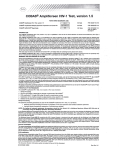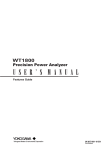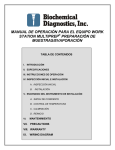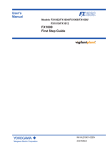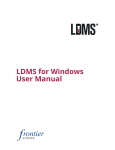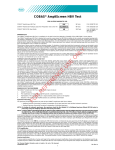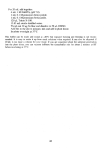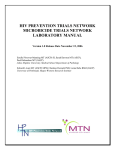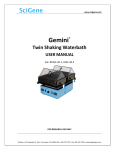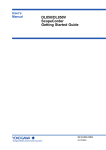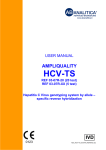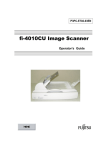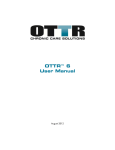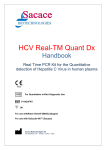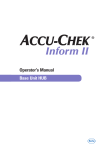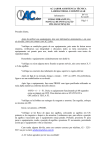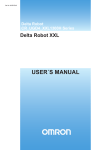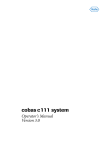Download Package Insert- HCV-NAT
Transcript
COBAS® AmpliScreen HCV Test, version 2.0
FOR IN VITRO DIAGNOSTIC
GOB~
HCV Test, version 2.0
AmpliScreen
GOBASI!!> AmpliScreen
Multiprep
COBASi!!> AMPUCOR
Specimen
USE.
HCV
Preparation
and Control
I
"rt
MULnPREP/CTL/
Wash Buffer
96 Tests
PIN: 03302563
018
96 Tests
PIN: 03302555
018
500 Tests
WB
PIN: 20759899 123
ART: 07 5989 9
US: 83314
INTENDED
USE
TIle GOBAS<!>AmpfiScreen HCV Test, version 2.0 (v2.0) is a qualitative in vitro test for the direct detection 01 Hepatitis C Virus Q-ICV) RNA in human plasma.
TIle COBAS@ AmpliSCreen Hey Test, v2.0 i. Intended to be used for the detection of Hey RNA in conjunction with licensed test. for detecting antibodies to HCV. This product is intended for use as a donor screening test to detect Hey in plasma specimens from individual human donors, including
donors of whole blood and blood components, source plasma and other 6ving donors. It is also irrtended for use to screen organ donors when specimens are obtained while the donor's heart is still beating and to detect HCV RNA in blood specimens from cadaveric (not'I'-heart-beating) organ and tissue
donors. This test is not intended for use on samples of cord blood.
Plasma from all donors may be screened as individual specimens. For donations of whole blood and blood components, plasma may be tested in pools
comprised of equal aliquots of not more than 24 individual dooations. For donations of hematopoietic stem/progenitor
cells Q-IPCs) sourced from bone
marrow, peripheral blood or cord blood, and donor lymphocytes for infusion (DU), plasma may be tested in pools comprised of equal a1iquots of not
more than 24 indMduai donor specimens. For dooations of source plasma. plasma may be tested in pools comprised of equal a6quots of not more than
96 IndMdual donations.
The COSAS® AmpHSCreen HCV Test, v2.0 can be considered
tive on a licensed donor screening test for antibodies to Hcv,
This test is not intended
SUMMARY
test that confirms
HCV infection for specimens
HCY Test, v2.0.
that are repeatedly
reac-
aid in diagnosis.
for use as an
AND EXPLANATION
a supplemental
and reactive on the COBAS<Ii>AmpiiScreen
OF THE TEST
Hepatitis C Virus is considered to be the principal etiologic agent responsible for 90-95% of the cases of post-transfusion
non-A and non-B hepatitis.T•2
HCV is a single-stranded,
positive sense RNA virus with a genome of approximately
10,000 nucleotides coding for 3,000 amino acids'! As a bloodborne virus, HCV can be transmitted by blood and blood products. The global prevalence of HCV infection, as determined by immunoserology,
ranges
from 0.6% in Canada to 1.5% in Japan.2
Serological screening assays have greatly reduced, but not completely eliminated, the risk of transmitting
viral Infections by transfusion of blood products.3-6 Recent studies indicate that nucleic acid-based ampflfJCalion tests for HCV RNA will allow detection of HCV infection earlier than the current
antibody based tests. Nucleic acid testing (NAl) of whole blood donations has been in place in the United States since 1999 under Investigational
New Drug Application OND). Nucleic acid-based tests can detect viremic units donated by carriers who do not seroconvert or who lack antibodies
to serological markers normally detected by Immunological assays.1-9
The COBAS@ AmpliScreen HCV Test, v2.0, uses a generic sample preparation technique in a mini-pool testing format
fication and detection using Polymerase Chain Reaction (PCR) on the CO~
AMPUCOR AnalyZer for the detection
tions. The assay incorporates
an Internal Corrtrol for monitoring
assay performance
in each individual
test
(uracil-N-glycosylase)
enzyme to reduce potential contamination
by previously amplified material (amplicon).
PRINCIPLES
OF THE PROCEDURE
The COBAS@ AmpliSereen
1. Sample
HCV Test, v2.0 is based on five major processes:
Processing
2. Reverse transcription
3. PCR amplification
4. Hybridization
of target RNA to generate complementary
10 of target cDNA using HCV-specific
of the amplified
products
5. Detection of the probe-bound
Sample
along with automated ampliof HCV RNA in blood donaas well as the AmpErase
amplified
to oligonucleotide
products
DNA (cDNA) 10
compiemerrtary
primers
probes specific
by colorimetric
to the target(s)
determination
Processing
1Wo specimen processing
procedures
Muniprep
Specimen
Standard
Sample
are used with the COBAS@ AmpliScreen
Processing
Processing
Procedure
for preparation
for preparation
of individual
HCV Test. v2.0 as follows:
of mini-pool
specimens
and individual
cadaveric
specimens
donor samples
NOTE: For testing of cadaveric specimens, the specimen should be first diluted 1:5 in Multiprap Specimen Diluent (MP OIL) prior to
processing using the Multiprep Specimen Processing Procedure.
In the Standard Specimen Processing Procedure, HCV RNA is isolated directiy from plasma by lysis of the virus particles with Multiprep Lysis Reagent
followed by precipitation
of the RNA with alcohol. In the Multiprep Specimen Processing Procedure, HCV viral particles are first pelleted from the
plasma sample by high speed centrifugation,
followed by lysis of the pelleted virus with a chaotropic agent (Multiprep lysis Reagerrt) and precipitation of the RNA with alcohol.
The Muniprep Irrtema! Control (MP Ie), containing the HCV Intemal Corrtrol, is introduced irrto each sample with the Multiprep lysis Reagerrt and
s~rves as an ext:-,~n
and ampfificatlon control for each processed specimen and control. The HeV Internal Control is an RNA transcript with primer
bIndIng regIOns IdentIcal to those of the HCV target sequence, a randomized internal sequence of similar length and base composition
as the HCV
target sequence, and a unique probe binding region that differentiates the HCV Internal Control amplicon from target amp/icon. These features were
selected to ensure equivalerrt amplification of the HCV Internal Control and the HCV target RNA.
Reverse
Transcription
The reverse transcription
and amplification
reactions are performed
with the thermostable
recombinant
enzyme Thermus thermophitus
DNA
Polymerase
(rTth poI). In the presence of manganese (Mn2+) and under the appropriate
buffer conditions,
rTth pol has both reverse transcriptase and DNA polymerase activity.TO This allows both reverse transcription
and peR amplification
to occur In the same reaction mixture. Reverse
transcription
using rTth pol produces a cDNA copy of the HCY target and the HCV Internal Control RNA.
PCR Amplification
Following reverse transcription
using rTlh pol, a second DNA strand is produced from the cDNA copy, thereby yielding a double-stranded
DNA copy
of the HCV target and HCV Intemal Control RNA. The reaction mixture is heated to separate the resulting double-stranded
DNA. As the mixture cools,
pnrners anneal to the target DNA and in the presence of Mol!+ and excess deoxynucieotide
triphosphates
(dNTPs), the r7th pol extends the annealed
pnmers along ~ target ternplates to produce a double-stranded
DNA molecule termed an ampiicon. The COB~
AMPUCOR Analyzer automatically repeats this process for a designated number of cycles, each cycle effectively doubling the amount of amplicon DNA. The required number of
cycles IS preprogrammed
In the
AMPUCOR Analyzer.
coBAs®
The Document Revision tntomston section is located at the end of this rJacument
05T20713001-03EN
Doc Rev. 2.1
5elecliVe AmPlification
To eneure seie!;tive amplification
of nucleic acid target In the sample and prevent amplification
of pre-existing amplicon, AmpErase (uracil-N-glycosylaee] enzyme is added to the COBAS<IiI AmpliScreen
HCY Test, v2.0. The AmpErase enzyme recognizes and catalyzes the destruction
of DNA
strands containing deoxyuridine 11, but not DNA containing deoxythymidine.
Deoxyuridine
is not present in naturally occurring DNA, but is always present in amplicon because of the use of deoxyuridine
triphosphate
in place of deoxythymidine
triphosphate
as one of the dNTPs in the Master Mix
reagent; therefore, only amplicon contain deoxyuridlne.
Deoxyuridlne renders contaminating
ampllcon susceptible to destruction
by the Amp Erase
enzyme before amplification of the taryet DNA. The AmpErase enzyme, which Is included in the Master Mix reagent, catalyzes the cleavage of DNA,
thereby rendering the DNA non-amplifiable.
The AmpErase enzyme is Inactive at temperatures
above 55'C, i.e., throughout the thermal cycling steps,
and therefore does not destroy target amplicon. Following amplification, any residual enzyme is denatured by the addition of the Denaturation Solution,
thereby preventing the degradation of any target amplicon.
.
Hybridization
Reaction
Following PCR amplification, the COBAS@ AMPLICOR Analyzer automatically
adds Denaturation Solution to the A-tubes to chemically denature the
HCY ampllcon and the HCY Internal Control amplicon to form single-stranded
DNA Aliquots of denatured amplicon are then transferred to two detection cups (D-cups). A suspension of magnetiC particles coated with an oligonucleotide
probe specific for HCV amplicon or HCV Intemal Control amplicon
is added to the individual D-cups. The biotin-labeled HCV target and HCV IntemaJ Control amplicon are hybridized to the target-specifIC oligonucleotide
probes bound to the magnetic particles. This hybridization of amplicon to the target-specific
probe increases the overall specifictty of the test.
Detection
Reaction
Following the hybridization reaction, the COB~
AMPUCOR Analyzer washes the magnetic particles in the D-cups to remove unbound material,
and then adds avidin-horseradish
peroxidase conjugate. The avidin-horseradish
peroxidase conjugate binds to the hybridized biotin-labeled
arnplicon,
The eOBAS4i AMPUeOR
Analyzer removes unbound conjugate by washing the magnetic particles and then adds a substrate solution containing
hydrogen peroxide and 3,3',5,5'-tetramethylbenzidlne
(TMB) to each D-cup. in the presence of hydrogen peroxide, the particle-bound
horseradish
peroxidase catalyzes the oxidation of TMB to form a colored complex. The absorbance is measured by the eOBAS@ AMPLICOR Analyzer at a wavelength of 660 nm.
MATERIALS
PROVIDED
BY ROCHE
The COBASt!I> AmpliSereen
Multiprep Specimen Preparation and Control Kit and the COBAS® AMPLICOR Wash Buffer kit are provided as standalone kits to be used In conjunction
with the COBAS® AmpllScreen
Hey Test, v2.0, as well as the COBAS@ AmpliScreen
HIY-l Test, v1.5, and
the COBAS® AmpliScreen
HBY Test.
COBASt!i> AmpliScreen
018)
Multiprep
Specimen
Preparation
and Control
Kit
96 Tests
I MULTlPREP/CTl.I
(PIN: 03302555
MP(-)C
(MuHiprep
Negative
MP(+)C
(Multiprep
Posltive
(-) Control)
(+) ControQ
MPLYS
(Mulliprep
Lysis Reagent)
MPDIL
(Multiprep
Specimen
MPIC
(MuHiprep
Internal
NHP
(Negative
Diluent)
ControQ
Plasma
(Human»
COBAS«> AmpliScreen
(PIN: 03302563018)
HCY Test, version
2.0
COBAS«> AmpliScreen
HCY Amplification
Reagents,
96 Tests
HCV
version
2.0
HCV
AMP
HCY MMX, v2..0
(HCV Master Mix, version 2.0)
HCV Mn2+, v2.0
(HCY Manganese Solution, version
COBAs0
AmpliScreen
HCY Detection
CH PS1, v2.0
(HCY Probe Suspension
CH4, v2.0
(HCV Probe Suspension
CI PS1
(IC Probe Suspension
CI4
(IC Probe Suspension
1, version
A)
SB
(Substrate
B)
2.0
version
HCVOK
2.0)
2. version 2.0)
1)
2)
DN4
(Denaturation
Solution)
CN4
(Avidin - Horseradish
Peroxidase
SB3
(Substrate
2.0)
Reagents,
Conjugate)
COBAs0
AMPUCOR
Wash Buffer
(PIN: 20759899 123; ART: 07 5989 9; US: 83314)
WB
(10X-Wash
OTHER
Concentrate)
MATERIALS
•
500 Tests
WB
REQUtRED
BUT SOLD
SEPARATELY
version
Printer,
ROCHE)
•
COBAs<!!> AMPLICOR
D-cups
•
AMPULINK
version
•
Hamilton MICROLAB@ AT Pius 2 Pipettor (with Hamilton SUN PLUS and RUNENDE Software, and the Roche Pooling Methods Software,
versron 1.3), the COBAS® Amp~IScreen P?ohng System GUIde (Roche Pooling Methods
Software,
version 1.3 and the COBAS®
AmphScreen Pooling System GUIde are validated to prepare pools of equal aliquots of not more than 24 individual plasma donations
using Hamilton MICROLAB AT Plus 2 Pipettor with HamiHon SUNPLUS and RUNENDE Software).
•
Additional MP OIL from the COBASI2> AmpliScreen
enc specimens
1.4 and Operator's
0022B,
FROM
Analyzer
A-rings
Software,
with software
(MAY BE PURCHASED
COBAS@ AMPLICOR
COBAS@ AMPLICOR
and Operator's
Manual for the AMPULINK
Mulliprep
Specimen
Manual for the COBAS®
AMPUCOR
Analyzer
software
Preparation
and Control
Kit Is required
for testing
of
cadav-
NOTE: The user must validate all pooling algorithms and equipment other than those supplied by Roche.
•
Sarstedt
1.5-mL
•
Hamilton
Archive
•
Refrigerated high speed centrifuge with fixed angl.e rotor (45 degrees. capacity for at least 24 x 1.5-mL tubes) with an RCF of 23,600
x g (Heraeus Centrifuge 17RS or Biofuqe 28RS with HFA 22.1 rotor, Heraeus Biofuge Stratos with the 3331 rotor or equivalent).
05120713001-03EN
tube Barcode
Labels
and Intermediate
Plate Barcode
Labels
Doc Rev. 2.1
MAT~RIALS R~QUIR~D BUT NOT PROVlD~D BY ROCHE
•
Mlerocentrifuge,
•
(max. RCF 16,000
x
g, min. RCF 12,500 x g) (EppendorJ<!!> 5415C. HERMLE Z230M,
Eppendorf 1.25 mL Eppendorf
Comb~ip@
Eppendorf
pipette
or equivalent
reagent
grade for Molecular
Multlpette~
Ethanol,
90%
or 95%,
Distilled
or deionized
Reservoir
•
Powder1ess.
Isopropyl
disposable
•
Disposable.
•
Sterile,
•
Pipettors (capactty 20 IJL to 1000 1J1, capable
placement RNase-free tips
RNase-free,
•
Tube racks (Sarstedt
•
1.S-mL sterile,
•
Vortex mixer
or Histology
use
gloves
reagent
Sterile.
Biology
water
•
alcohol.
or equivalent)
(sterile) or equivalent
grade
Polystyrene
fine-tip
(5 mL, 10 mL and 25 mL)
pipettes
transfer
pipettes
of providing
± 3% accuracy
and precision"
5%) with aerosol
barrier
or positive
dis-
PIN 93.1428 or equivalent)
non-siliconized,
•
Hami~on
Slotted
Deepwell
•
Hamilton
Slotted
Imermediate
conical
Archive
polypropylene
screw-cap
Plate. 2.2 mL and Sealing
tubes.
(Sarstedt
72.692.105
or equivalent)
Capmat
Plate
REAGENTS
COBAs«'
AmpliScreen
MP(-jC
(Multiprep
Multiprep
Negative
Specimen
Preparation
and Control
I MUL1lPREP/cn.1
Kit
96 Tests
axO.1
mL
a x 0.1
mL
H ControO
< 0.005% Poly rA RNA (synthetic)
EDTA
0.05% Sodium azide
MP(+)C
(Multi prep Positive
(+) ControO
Tris-Hel buffer
< 0.001 % Non-infectious
linearized plasmid
< 0.001 % Non-infectious
in vitro transcribed
< 0.001 % Non-infectious
in vitro transcribed
< 0.005% Poly rA RNA (synthetic)
EDTA
0.05% Sodium azide
DNA (microbial) containing
RNA (microbial) containing
RNA (microbiaO containing
HBV sequences
HeV sequences
HIV-l sequences
MPLYS
(Multi prep Lysis Reagent)
Tris-HCI buffer
60% Guanidine
3% Dithiothreitol
< 1 %GJycogen
Xn
a
x 9.0 mL
a
x 4.a mL
thiocyanate
IX I
60% (w/w) Guanidine
thiocyanate
Harmful
MPDIL
(Multi prep Specimen
Diluent)
Tris-Hel buffer
< 0.005% Poly rA RNA (synthetic)
EDTA
0.05% Sodium azide
MPIC
(Multiprep
Internal
ax
Control)
Tris-HCI buffer
< 0.001 % Non-infectious
plasmid
unique probe binding region
< 0.001 % Non-infectious
in vitro
sequences and a unique probe
< 0.001 % Non-inlectious
in vitro
sequences and a unique probe
< 0.005% Poly rA RNA (synthetic)
EDTA
< 0.1 % Amaranth dye
0.05% Sodium azide
DNA containlnq
HBV primer
transcribed
RNA (microbiaO
binding region
transcribed
RNA (microbial)
binding region
binding
sequences
and a
containing
HCV primer
containing
HIV-l
primer
binding
binding
NHP
(Negative
0.1 mL
16 x 1.6 mL
Plasma
(Human»
Human plasma. non-reactive
by US FDA licensed
HIV p24 antigen and HBsAg
0.1 % ProClin® 300 preservative
COBAS®
AmpliScreen
HCV Test, version
2.0
COBAS®
AmpliScreen
HeV Amplification
Reagents
tests for antibody
to HCV, anlibody
HCV
to HIV-1/2,
96 Tests
HCVAMP
HCV MMX, v2.D
(HCV Master Mix. version
8 x 0.7 mL
2.0)
Bicine buffer
16% DMSO
Glycerol
< 0.01 % rTth DNA Polymerase (rTth pol, microbial)
Potassium acetate
< 0.001 % dATp, dCTP. dGTP, dUTP
< 0.005% KY7a and KYaO primers (KY78 is biotinylated)
< 0.01 %AmpErase (uracil-N-glycosylase)
enzyme (microbiaO
0.05% Sodium azide
HCV Mn2+, v2.0
(HeV Manganese
Solution.
version
8 x 0.1 mL
2.0)
< 2 % Manganese
Acetic acid
Amaranth dye
0.05% Sodium azide
0512D713001-03EN
3
Doc Rev. 2.1
COBASIID AmpiiScreen
HCV Detection
Reagents,
version
2.0
Hev DK
1 x 100 Tests
CH PS1 v2.0
(HCY Probe Suspension
1, version
2.0)
MES buffer
< 0.4% Suspension of DynabeadsllD (paramagnetic
oligonucleotide
capture probe KY150
0.09% Sodium azide
particles)
coated
with
HGY-specific
1 x 100 Tests
CH4, v2.0
(HeV Probe Suspension
2, version
2.0)
Sodium phosphate
buffer
34.7% Sodium thiocyanate
0.2% Solubilizer
IX 1
34.7% (w/w) Sodium
Xn
thiocyanate
Harmful
1 x 100 Tests
CI
PS1
(IC Probe Suspension
1)
MES buffer
< 0.4% Suspension of Dynabeads (paramagnetic
oligonucleotide
capture probe SK535
0.09% Sodium azide
particles)
coated
with
IC-specinc
1 x 100 Tests
CI4
(IC Probe Suspension
2,)
Sodium phosphate
buffer
24.9% Sodium thiocyanate
0.2% Solubilizer
1 x 100 Tests
ON4
(Denaturation
Solution)
1.6% Sodium
EDTA
Thymol blue
1
Xi
X
hydroxide
11.6%
(w/w) Sodium
hydroxide
Irritant
2
CN4
(Avidin-Horseradish
Peroxidase
x 100 Tests
Conjugate)
Tris-HCI buffer
< 0.001 % Avidin-horseradish
peroxidase conjugate
Bovine serum albumin (mammalian)
Ernulsit 25 (DaHchi Kogyo Seiyaku Co., Ltd.)
0.1% Phenol
1 % ProClin@ 150 preservative
10
SB3
(Substrate
x 75 Tests
A)
Citrate solution
0.01 % Hydrogen peroxide
0.1 % ProClin@ 150 preservative
SB
(Substrate
10 x 75 Tests
(10x5mL)
B)
0.1 % 3,3' ,5,5' -Tetramethylbenzidine
40% Dimethylformamide
(DMF)
T
1*1
40%
(TMB)
(w/w) Dimethylformamide
(DMF)
Toxic
R: 61-20/21-36
May cause harm to the unborn child. Harmful
and in contact with skin. Irritating to eyes.
S: 53-45
Avoid exposure - obtain special instructions before use. In
case of accident or if you feel unwell, seek medical advice
immediately
(show the label where possible).
COBAS<!!> AMPUCOR
Wash
by inhalation
WB
Buffer
500 Tests
we
2 x 250 Tests
(lOX-Wash
Concentrate)
c 2% Phosphate
buffer
< 9% Sodium chloride
EDTA
< 2% Detergent
0.5% ProClin® 300 preservative
STORAGE
INSTRUCTIONS
A.
Room Temperature
B.
Do not freeze reagents.
is defined as 15 - 30"C.
C.
Store the following reagents at 2 - BOC.Unopened, these reagents are stable until the expiration date indicated.
MP LYS, MP IC, MP (+) C, MP (-) C, MP DIL and NHP
HCY MMX, v2.0 and HCY Mn2+, v2.0
CH PS1, v2.0, CH4, v2.0, CI PSI
CN4,
sea
and CI4
and SB
we
D.
Store ON4 at 2 - 25 G. Store WB at 2 - 30 C. DN4 and
E
Do not expose 583, 58 or Working Substrate to metals, oxidizing agents or direct sunlight.
F.
The following
D
MP IC, MP
reagents
D
are stable until the expiration
dates indicated.
are one time use. Discard any unused portion.
(+) C, MP H C, MP OIL and NHP
HCY Mn2+, v2.0 and SB
05120713001-03EN
Doc Rev. 2.1
PRECAUTIONS
FOR
IN VITRO DIAGNOSTIC
USE.
A.
Specimens may be infectious. Use Universal Precautions when performing the assay.12-13. Only personnel proficient in the use of the COBASaD
AmpiiScreen System and trained in handling infectious materials should p<!rform this procedure. Thoroughly clean and disinfect all work surfaces
with a freshly prepared solution of 0.5% sodium hypochlorite in distilled or deionized water: Follow by wiping down the surface with 70% ethanol.
B.
CAUTION: The Negative Human Plasma (NHP) Of this kit contains human blood products non-reactive
by US FDA licensed tests for
antibody to HIV-1/2, antibody to HCV, HW-1 p24 antigen and HBsAg. No known test method can offer complete
assurance
that products derived from human blood will not transmit
infectious
agents. All human blood-sourced
materials
should be considered
potentially infectious
and should be handled with Universal Precautions.
If spillage occurs, immediately disinfect, then wipe up with a 0.5% (final
concentration)
sodium hypochlorite solution (diluted bleach) or follow appropriate site procedures.
C.
Use routine laboratory precautions. Do not pipette by mouth. Do not eat, drink or smoke in designated work areas. Wear disposable
laboratory coats and eye protection when handling specimens and kit reagents. Wash hands thoroughly after handling specimens
gloves,
and kit
reagents.
D.
This product contains sodium azide as a preservative. Do not use metal tUbing for reagent transfer. If solutions containing azide compounds
are disposed of In a plumbIng system, they should be diluted and flushed wtth generous amounts of running water. These precautIons are
recommended
to avoid accumulation
of deposlts in metal piping in which explosive conditions could develop.
E
Heparin has been shown to inhibit PCR. Do not use heparinized plasma with this procedure.
F.
Use only supplied
G.
Screw-cap tubes must be used for specimen
and controls.
Do not use snap cap tubes.
or specified
required disposables
vortex, where specified,
to ensure optimal
and control
assay performance.
to prevent
splashing
and potential
H.
Adequately
I.
Handle all materials containing
specimens or controls.
J.
Before use, visually inspect each reagent bottle to ensure that there are no signs of leakage and/or
leakage and/or abnormal color, do not use that bottle for testing.
K
Dispose
tions.
L
Do not use a kn after tts expiration
use expired reagents.
of all materials
to ensure optimal
preparation
specimens
according
with specimens
date. DO NOT interchange,
to Good
Laboratory
and reagents
mix, or combine
Practices
in accordance
reagents
in order to prevent
abnonnal
with country,
cross-contamination
color. If there Is any· evidence
of
of
federal, state and local regula-
from kits wHh different
master
lot numbers.
Do not
M.
Material
N.
Supplies and equipment must be dedicated to each pre-amplification
activity and should not be used for other activities or moved between
areas. Fresh, clean gloves must be worn in each area and must be changed before leaving that area. Equipment and supplies used for
reagent preparation must not be used for specimen preparation activities or for pipetting or processing amplified DNA or other sources of target
DNA. Post-amplification
supplies and equipment must remain In the Post-Amplification
Area at all times.
O.
Avoid contact of MP LYS, HCV MMX, v2.0, HCV Mn2+, v2.0, CH4, v2.0, CI4, DN4, CN4, SB3, SB and Working Substrate (mixed SB3 and
SB reagent) with the skin, eyes or mucous membranes. If contact does occur, immediately
wash with large amounts of water, otherwise
burns can occur. If these reagents are spilled. dilute with water before wiping dry. Do not aRow MP LYS, which contains
guanidine
thiocyanate, or CH4, v2.0 and CI4, which contain sodium thiocyanate,
to contact sodium hypochlorite
(bleach) solution.
This mixture can
produce a highly toxic gas.
P.
SB and Working Substrate
contain dimethylformamide,
to the unborn child. Skin contact, Inhalation of fumes
soap and water and seek medical advice immediately.
Q.
Refer to "Precautions" in the packege inserts accompanying
other COBAS® AmpliScreen products, the COBAS® AmpliScreen
Guide, and the Operator's Manuals for the AMPUUNK
software and COBAS<!> AMPLICOR Analyzer.
R.
Closely follow procedures
from the given procedures
S.
The use of excessively
REAGENT
A.
Safety Data Sheets (MSDS) are available
of specimens
assay performance,
or controls
that have come in contact
cross-contamination
on request.
which has been reported to be toxic in high oral doses and may be harmful
and ingestion
should be avoided. If skin contact occurs, wash thoroughly
with
and guidelines provided to ensure that the specimen and control preparation
and guidelines may affect optimal assay performance.
hemolyzed
cadaveric
specimens
should
correctly.
Any deviation
be avoided.
PREPARATION
MP IC, MP
(+J C, MP (-) C, MP DlL and NHP
1. Warm MP IC, MP (+) C. MP 1-) C, MP OIL and NHP to room temperature
bench
B.
is performed
Pooling System
before
use by using a 37"C incubator
or on the laboratory
top.
Working
Lysis Reagent
1. Warm MP LYS to 25 - 37"C to dissolve precipitate
(maximum 30 minutes).
Mix thoroughly
until the crystals are dissolved.
Prior to
use, examine each bottle of MP LYS against a white background
for appearance of a yellow color or signs of leakage.
If there is any
yellow color or signs of leakage do not use that bottle for testing. Contact your local Roche office for replacement.
2. Vortex MP IC briefly before use. Tap vial to collect the solution in the base. Pipette 100 ~L MP IC into 1 bottle MP LYS. Cap the
MP LYS bottle and vortex briefly. The pink color confirms that the MP IC has been added to the MP LYS. Discard the remaining MP IC.
3. Store Working Lysis Reagent at mom temperature.
C.
Working
Amplification
Master
Use within 4 hours of preparation.
Mix
1. Prepare Working Master Mix in a template-free
fected
in accordance
with methods
outlined
area (e.g., in a dead air box). Reagent preparation
area must be clean and disinin Precautions
Otem A). Failure to do so may result in reagent contamination.
2. Pipett.e 100 ~L HCV Mn2+, v2.0 into 1 bottle HCV MMX, v2.0. Recap HCV MMX, v2.0 bottle and mix well by inverting
The pink color confirms
not vortex the Working
D.
that the HCV Mn2+, v2.0 has been added to the HCV MMX, v2.0. Discard the remaining
Master Mix. These reagents clo not need to be at room temperature
before use.
3. Store
at 2 - S'C and use within 4 hours of preparation.
Working
Probe
Suspension
Detection
Reagents
1. Prepare Working HCV Probe Suspension:
Mix CH
CH PS1, v2.0 into one CH4, v2.0 cassette.
2.
Prepare
Working
10-15 times.
HCV Mn2+, v2.0. Do
IC Probe Suspension:
PSI, v2.0 well by vortexing
Mix CI PS1 well by vortexing
briefly to suspend
briefly to suspend
the microparticles.
the microparticles.
Pipette
Pipette
2.5 mL
2.5 mL CI PS1 into
one CI4 cassette.
3.
Both Working Probe Suspension Detection Reagents are stable for 30 days at 2 - S'C. Working Reagents can be used for a maximum
of ten instrument
cycles (12 hours per cycle). Mixing occurs automatically
on the COBAS® AMPLICOR Analyzer.
4. Store Working Probe Suspension
Detection Reagents
before use on the COBAS@ AMPLICOR Analyzer.
E.
DN4 - Denaturation
Reagent
and CN4 Conjugate
at 2 - S'C between
instrument
F.
Working
Substrate
1. Working
05120713001-03EN
Substrate
Remove
from
refrigerator
30 minutes
Reagent
1. Once opened, DN4 and CN4 are stable for 30 days at 2 - S'C, or until the expiration
can be used for a maximum of ten instrument cycles (12 hours per cycle).
2. Store ON4 and CN4 at
Analyzer.
cycles.
2 - S'C between instrument
cycles.
Remove from refrigerator
date, whichever
30 minutes
comes
first. Both DN4 and CN4
before use on the COBAS®
AMPLICOR
Reagent
must be prepared
each day by pipetling
5 mL SB into one SB3 cassette. Pipette up and down at least 5 times to mix.
Doc Rev. 2.1
2. Working
Substrate
is stable
on the COBAS@ AMPUCOR
3. Do not expose SB3. SB or Working Substrate
G.
Wash
to metals,
Analyzer
for a maximum
oxidizing
agents.
or direct
of 16 hours.
light.
Buffer Reagent
we
1. Examine
before dilution and if necessary. warm at 30 - 37"C to dissolve any precipitate.
Add 1 volume of WB to 9 volumes of distilled or deionized water. Mix well. Keep a minimum of 3 - 4 liters of Working Wash Buffer (1 Xl in the Wash Buffer ReservOir of the
COBAS@ AMPUCOR Analyzer at all times.
2. Working Wash Buffer (1 Xl should be stored at 2 - 25'C in the COBAS(!l> AMPLICOR
Wash Buffer
Reservoir
and is stable
for 2 weeks
from the date of preparation.
H.
70% Ethanol
1. Prepare 70% ethanol fresh daily.
2. One mL 70% ethanol is needed for each specimen and control processed.
For example.
tilled or deionized water for every 12 specimens
and controls to be processed.
mix 11.7 mL 90% ethanol
and
3.3 mL of dis-
SPECIMEN COu.ECnON, STORAGE AND POOLING
NOTE: Handle all specimens as if they are potentially infectious agents.
living
Donor
A.
EDTA, CPO, CPOA-1, CP20, ACD-A and 4% Sodium
manufacturer's
instructions.
Speeimens
B.
Blood collected in EOTA may be stored at 2 - 30°C for up to 72 hours from time of draw, followed by an additional two days at 2 - 8°C. For
storage longer than five days. remove the plasma from the red blood cells by centritugation
at 800 - 1600 x g for 20 minutes. Following removal.
plasma may be stored at 2 - S'C for an additional seven days. AHemativeiy, plasma may be stored at s -18'C for up to one month.
:--2 to
Citrate may be used with the COBAS@> AmpliScreen
HCV Test. v2.0. Follow sample tube
30°C .•.••
30
6'
~
~
::J
Whole
Blood
1ii
'(])
c.
2 to BOG
E
8
~
I
2
2
0
4
3
I
Plasma
5
7
6
8
9
10 11 12 13 14 15
Days Post Collection
C.
Blood collected in CPO. CPDA-1, or CP20 may be stored for up to 72 hours at 1 - 24°C. Following centrifugation
of the CPO. CPOA-1,
or CP20 samples at 800-1600 x g for 20 minutes. plasma may be stored at 1 - 6'C for an additional
7 days from the date the plasma
was removed from the red blood cells. Plasma separated from the cells may be stored at ,; -18OC for up to one month.
O.
ACO-A or 4% sodium citrate anticoagulated
at s -1SoC for up to one month.
apheresis
plasma
can be stored
at 1 - 6°C for up to 6 hours.
E.
Do not freeze whole
F.
Heparin has been shown to inhibit peR. Use of heparinized specimens is not recommended.
G.
Warm pooled or individual donor specimens
H.
Covered
I.
No adverse
J.
Thaw frozen specimens
K.
The user should validate other collection and storage
in compliance with applicable federal and international
L
False positive results may occur if cross contamination
processing.
M.
SPECIMEN POOLING:
Archive
effect
followed
by subsequent
storage
blood.
Plates may be stored
to room temperature
before using.
at 2 - 8°C for up to 7 days from the date the plasma
on assay performance
was observed
at room temperature
before
when plasma
specimens
was removed
were subjected
from the red blood
to three freeze-thaw
cells.
cycles.
using.
conditions.
If specimens
are to be shipped, they should
regulations covering the transport
of clinical specimens
of specimens
is not adequately
controlled
be packaged
and etiologic
and labeled
agents.14
during specimen handling and
NOTE: Pooling of specimens should only be perfonned on individual whole blood and source plasma donations, or on plasma specimens from donors of hematopoietic
progenitor
cells or donor lymphocytes
for infusion.
Cadaveric
specimens
must be tested
individually and not as part of a pool.
1.
The COBAS@ AmpliScreen
Pooling System performs barcode scanning and pooling operations
that combine aliquots from 24 individual samples into a single Primary Pool that is used for testing. The pooling algorithm
requires preparation
of Secondary
Pools as
well as individual specimens for follow-up testing in the event a Primary Pool tests positive. If fewer than 24 specimens
are available,
testing is performed using the individual specimens.
2.
For Source Plasma, the Hamilton MICROlAB AT Plus 2 Pipettor performs barcode scanning and pooling operations that combine
aliquots from 96 individual samples into a single Primary Pool that is used for testing. Positive Primary pools are traced to the positive donor using an overlapping pool testing matrix. Minipools are prepared from the eight individual donations for columns 1-12 and
from the 12 individual donations for rows 1-8. The positive unit is identified
by the intersection
of the positive column and positive
row. Confirmatory
testing is conducted
on the implicated
unit using Standard
Specimen Processing
Procedure.
(HamiHon MICROLAB AT Plus 2 Pipettor
of plasma during clinical trials).
with the SUNRISE
PLUS v3.3 software
was used to prepare
pools
of up to 96 equal aliquots
NOTE: The user must validate all pooling algorithms and equipment other than those supplied by Roche.
Cadaveric
N.
Blood
Cadaveric
Specimens
blood specimens
can be collected
NOTE: A serum or plasma specimen
collected
in serum or EOTA anticoagulant
tubes.
from a donor prior to death may be tested instead
of a cadaveric
blood specimen
using
either the instructions for cadaveric donor specimens or the instructions for living donor blood specimens.
O.
For ccllection. storage and handling of specimens from deceased donors. follow general standards andlor regulations.
be stored for up to 72 hours at refrigerated conditions (2-S'C), or up to 48 hours at ambient temperature
(15-30°C).
dling conditions must be validated by the user.
Cadaveric samples may
Other storage and han-
NOTE: Cadaveric samples should I". placed at 2-8'C as soon as possible after collection. The use of excessively hemolyzed cadaveric
specimens should be avoided.
05120713001-03EN
Doc Rev. 2.1
PROCEDURAl
A.
NOTES
Run Size
Each kfi contains reagents sufficient for eight 12-specimen runs, which may be performed separately or simultaneously. At least one
preparation of the COBAS@AmpliScreen Multiprep Negative (-) Control and one preparatton of the C08AS® AmpilScreen Multlprep
PosHive (+) Control must be included in each A-ring (see 'Quality Control' section).
1.
2. The Specimen Preparation and Amplification Reagents are packaged In eight single-use bottles. The Multiprep Negative (-) and
Multiprep Positive (+) Controls are packaged in single-use vials. For the most efficient use of reagents, specimens and controls should
be processed in batches that are multiples of 12.
3. The use of sterile gauze, when uncapping sample tubes may reduce the potential for cross contamination between specimens.
S.
Equipment
1. Prepare the C08AS® AMPUCOR Analyzer and the Data Station for the AMPLIUNK Software for use according to instructions in the
Operator's Manual for the AMPUUNK software and the Operator's Manual for the C08AS@ AMPUCOR Analyzer.
C.
2.
Preparethe Hamitton MICROLABAT Plus 2 System and SUNPLUS Data Station for use according to instructions in the Operator's Manuals.
3.
Pre-cool the high-speed centrifuge and rotor to 2 - BOC.See operating instructions for the high speed centrifuge for details.
4.
Perform manufacturer recommended maintenance and calibration on all instruments, including pipettors, to ensure proper functioning.
Reagents
1.
All reagents except HCV MMX, v2.0 and HCV Mn2+, v2.0, must be at room temperature before use. Visually examine reagents for
sufficient volume before beginning the test procedure. See section "Reagent Preparation' for specific reagent storage conditions.
2. Add all reagents using a pipettor capable of delivering specified volume with ± 3% accuracy and a precision of S 5% CV. Check
pipettor functionality and calibrate as recommended by pipettor manufacturer.
3.
D.
Prepare Working Master Mix in a template-free area (e.g., in a dead air box). Reagent preparation area must be clean and disinfected in accordance with methods outlined in "Precautions" (Item A). Failure to do so may result in reagent contaminatio.n.
4.
Prepare 70% ethanol fresh each day.
5.
Check expiration date of opened or Working Reagents before loading on the COSAs<!!>
AMPUCOR Analyzer.
6.
Check to ensure that all reagents used are of the same master lot of kit reagents.
Workflow
1. To minimize the possibilily of laboratory areas becoming contaminated with amplicon, the laboratory area should be separated into
several distinct areas organized around Pre-Amplification and Post-Amplification. Personnel should use proper anti-contamination
safeguards when moving between areas.
2. The Pre-Amplification Area should have a template-free area for preparation of WorKing Master Mix and an amplicon free area for
specimen and control preparation.
3. The Post-Amplification Area should have a C08AS® AMPUCOR Analyzer(s) and AMPULINK Data Station(s) with additional area for
preparing Working Amplification and Detection Reagents.
4.
Pipettors and other supplies should be dedicated to a specific area. Samples, equipment and reagents should not be returned to the
area where a previous step was perfonned.
E.
Temperature
F.
Vortexing
G.
Pipetting
Room temperature is defined as 15° to 30"C.
Proper vortexing during sample preparation is important to ensure homogeneous mixture after additions of reagents.
1. Pooled or individual plasma specimens must be at room temperature before pipetting.
H.
2.
Use a clean pipette tip or disposable transfer pipette with each specimen or control. Use aerosol barrier or positive displacement
RNase-free tips.
3.
Confirm that all pipettors are correctly set to dispense the specified volumes in accordance with the specimen preparation procedures
and guidelines.
Specimen
Processing
1. Screw-cap tubes must be used for specimen and control preparation to prevent splashing and potential cross-contamination of specimens and controls. Do not use snap cap tubes.
2. Avoid contaminating gloves when manipulating specimens.
Specimens and controls should be prepared in a laminar flow hood. Failure to do so may result in sample contamination.
Specimen
and control preparation area must be cleaned and disinfected in accordance wilh methods outlined in 'Precautions' (Item A).
Decontamination
3.
Thoroughly clean and disinfect all work surfaces with a freshly prepared solution of 0.5% sodium hypochlorite in distilled or deionized
water. Follow by wiping down the surface with 70% ethanol.
INSTRUCTIONS FOR USE
Specimen Processing Procedure is used for extracting nucleic acid from pooled specimens and from individual cadaveric specimens.
The Standard Specimen Processing Procedure is used for extracting nucleic acid from individual specimens. The Muttiprep Specimen Processing
Procedure is also used for testing minipools of source plasma
The Multiprep
The Munlprep and the Standard Specimen Processing Proceduresare generic nucleic acid extraction procedures and can be used for the extraction
of HCV RNA. HIV-1 RNA, andlor H8V DNA. A single extraction is sufficient for multiple assays. Workflow can be performed on the same day or over
multiple days under the following conditions:
Amplification. Hybridization and Detection of Stored Processed Specimens
Amplificati~n. hybridization and detection can occur on the same day as specimen processing or on a subsequent day. If amplification, hybridization
and detection are to be done on a subsequent day, perform the Multiprep Specimen Processing Procedure described in steps B1 through B21 or
the Standard Specimen Processing Procedure described in steps 822 through 83B. Store the processed specimens and controls as indicated. On
the subsequent day, begin wilh Step A (ReagentPreparation - Working Master Mix), thaw processed specimens and controls at room temperature,
and continue with Step 839.
Hybridization
and Detection of Stored Denatured Amplicon
Hybridization and detection of the denatured amplicon may occur on the same day as amplification or on a subsequent day. If hybridization and
detection are to be done on a subsequent day, the denatured ampficon may be left on-board the COBAS®AMPUCOR Analyzer for not more than
24 hours before starting the hybridization and detection steps. Mernatively, the denatured amplicon may be stored at 2 - BOCfor not more than five
days before starting the hybridization and detection steps.
A.
Reagent Preparation - Working Master Mix
A1.
Oeterrnms the appropriate number of A-ring(s) needed for specimen and control testing.
A2.
Place the A-ring(s) on the A-ring holder(s).
Perfonned in: Pre-Amplmeation - Reagent Preparation Area (e.g., dead air box)
05120713001-03EN
Doc Rev.2.1
A3.
For each A-ring,
A4.
Pipette
A5.
Place the A-ring containing Working
Working Master Mix was prepared.
AS.
Store the A-ring(sJ containing Working Master Mix at 2 Master Mix must be used within 4 hours of preparation.
A7.
Decontaminate
B.
Specimen
area. See
and Control
Perfonned
Specimen
Master Mix in a sealable bag and seal the plastic
'Procedural Nows',
aoc
until specimen
bag. Record the assay name (HC\/) and the time the
and control
preparation
is completed.
The A-rings
Item I.
- Specimen
Processing
and Control
Procedure
(pooled
Preparation
Specimens
Area
and Individual
Cadaveric
Specimens)
For pooled specimens, pipette 1000 ~L of each pool into an appropriately
System, a hand-held
with Working
Preparation
in Pre-Amplification
Muttiprep
Bl.
prepare one Working Master MiX.
50 ~L Working Master Mix into each A-tube. Discard unused Working Master Mix. Do not close the covers of the A-tubes at this time.
pipettor
or other user-validated
labeled screw-cap tube using the COBAS®
Cap the tubes. Proceed to Step 82.
method.
AmpliScreen
Pooling
For individual cadaveric specimens, pipette 200 ilL into an appropriately
using a hand-held
82.
83.
pipettor
or other user-validated
method.
labeled screw-cap tube and add 800 J.ll Muniprep Diluent (MP DlLJ
Cap the tubes. Vortex each specimen tube briefly. Proceed to Step 82.
Vortex NHP briefly.
For each Negative
and Positive Control pipette
1000 ~L NHP into an appropriately
labeled
screw-cap
tube. Cap the tubes.
For cadaveric testing, pipette 200 ~l NHP into an appropriately
hand-held
pipettor
or other user-validated
method.
marker to make an orientation
labeled screw-cap tube and add SOO ~l Multiprep
Cap the tubes. Vortex each specimen tube briefly.
OIL) using a
Diluent (MP
B4.
Use a pennanent
85.
Place the specimen and control tubes into the pre-cooled high-speed
tation marks will align with the pelle!s fonned during centrifugation.
mark on each tube.
86.
Centrifuge specimens and control
cated by the orientation mark
87.
Remove the tubes from the centrifuge and remove the caps. Slowly aspirate 900 ut, of the supernatant
from each centrifuged tube leaving
approximately 1 00 ~L of supematant. Avoid contact with the pelle!. Discard the supematant
and pipette tip appropriately.
Use a fresh pipette
tip for each tube.
8B.
Prepare a Working
89.
Pipette
810.
so that the orien-
at 2 - S'C. The pellet will fonn on the outer wall as indi-
23,000 - 24,000 x g.
Reagent bottle for every batch of 12 specimens
and controls
Neoative
to be processed.
as follows:
Control
Vortex MP (-) C briefly. Tap vial to collect the solution in the base.
Working lysis Reagent and NHP. Cap the tube and vortex briefly.
b.
marks facing outward,
BOO III Working Lysis Reagent into each specimen and control tube. Cap and vortex tubes briefly.
Prepare Controls
a.
wtth the orientation
tubes at 23,000 - 24,000 x g for 60 ± 4 minutes
NOTE: The 60 ± 4 minutes begins when-the centrifuge reaches
lysis
centrifuge
Positive
Pipette
20 ~L MP (-) C to the tube labeled
'MP
H C'
containing
Control
Vortex MP (+) C briefly. Tap vial to collect the solution in the base. Pipette
Working Lysis Reagent and NHP. Cap the tube and vortex briefly.
811.
Incubate all tubes for 10 to 15 minutes
briefly vortex all tubes.
812.
Pipette 700
813.
Place the tubes into a microcentrifuge
with the orientation
1750 x g for 15 - 20 minutes at room temperature.
814.
Slowly aspirate the supematant
815.
Pipette 1.0 ml of 70% ethanol into each tube. Cap the tubes and vortex
III of isopropanol
at room temperature
after adding
into each tube. Cap the tubes and vortex
III MP (+) C to the tube labeled 'MP (+J C· containing
20
Working
lysis
Reagent to the last tube. After the incubation
period,
briefly.
marks facing outward
to align with the pellets that will form. Centrifuge
from each tube. Remove as much liquid as possible
without
disturbing
at 14,250 ±
the pellet.
briefly.
816.
Place the tubes into a microcentrifuge
with the orientation
1750 x g for 5 - 10 minutes at room temperature.
817.
Slowly aspirate the supematant from each tube using a fine-tip
turbing the pellet. Use a new transfer pipette for each tube.
818.
Using a new transfer pipette for each tube, repeat Step 817 to remove as much of the remaining
the pellet. Residual ethanol can inhibit amplification.
819.
Pipette 200 ut, MP OIL into each tube. Use a pipette tip to break apart the pellet. This can be done by aspirating 30-40 ilL of the diluent in
the tip and scraping the sides and base of the tube in an up/down motion for at least 10 seconds and dispensing 30-40 ut, Cap the tubes
and vortex briefly to resuspend the extracted RNA. Note that some insoluble material may remain.
820.
At this point amplification
of the processed specimens and controls must be started within 2 hours. If not, the processed specimens
trols can be stored at -70°C or colder for up to one month. Thawing should be completed within one hour at room temperature.
821.
Proceed to step 839,
LDading the A-ring.
Standard
ProceSSing
Specimen
Procedure
pndividual
marks facing outward
disposable
Specimens
Pipette 200 ilL of each specimen into an appropriately labeled screw-cap
pipettor or other user-validated method. Cap the tubes.
823.
Vortex NHP briefly.
For each Negative and Positive Control pipette 200 ut, NHP into appropriately
825.
Use a permanent
826.
Prepare a Working
Pipette
82B.
Prepare Controls as follows:
a.
labeled
screw-cap
at 14,250 ±
as much liquid as possible
supernatant
and Source
Plasma
as possible
without
dis-
disturbing
and con-
Minipools)
AmpliScreen
tubes.
without
Pooling
System,
a hand-held
Cap the tubes.
mark on each tube.
Lysis Reagent bottle for every 12 specimens
and controls
to be processed.
BOO pl, Working lysis Reagent into each tube. Cap and vortex tubes briefly.
Negative
Control
Vortex MP (-J C briefly. Tap vial to collect the solution in the base. Pipette
taining Working lysis Reagent and NHP. Cap the tube and vortex briefly.
b.
Remove
tube using the C08AS®
824.
827.
pipette.
(Non-Cadaveric)
822.
marker to make an orientation
to align with the pellets that will form. Centrifuge
transfer
Positive
'MP
(-) C· con-
20 ~L MP (+) C into the tube labeled
'MP
(+J C' con-
Control
Vortex MP (+) C briefly. Tap vial to collect the solution in the base. Pipette
taining Working lysis Reagent and NHP. Cap the tube and vortex briefly.
829.
In?ubate all tubes for 10-15 minutes
bnefly vortex all tubes.
830.
Pipette
BOO jJL of isopropanol
at room temperature
after adding
Place the tubes into ~ microcentrifuge
with the orientation
1750 x g for 15-20 minutes at room temperature.
832.
Slowly aspirate the supernatant
lysis
marks faCing outward
Reagent
to the last tube. After the incubation
to align with the pellets that will form. Centrifuge
from each tube. Remove as much liquid as possible
833.
Pipette 1.0 ml of 70% ethanol
834.
Place the tubes into a microcentrlfuge
with the orientation
1750 x g for 5 - 10 minutes at room temperature.
835.
Slowly aspirate the supernatant from each tube using a fine-tip
turbing the pellet. Use a new transfer pipette for each tube.
836.
Using a new transfer
the pellet. Residual
pipette
Working
period,
into each tube. Cap the tubes and vortex briefly.
831.
05120713001-03EN
III MP (-) C into the tube labeled
20
into each tube. Cap the tubes and vortex
disturbing
at 14,250 ±
the pellet.
briefly.
marks facing outward
disposable
without
to align with the pellets that will form. Centrifuge
transfer
pipette.
Remove
for each tube, repeat Step 835 to remove as much of the remalninq
as much liquid as possible
supernatant
as possible
without
at 14,250 ±
without
dis-
disturbing
ethanol can inhibit amplification.
Doc Rev. 2.1
837.
Pipette 200 fJL MP OIL into each tube. Use a pipette tip to break apart the pellet. This can be done by aspirating 30-40 fJL of the diluent in
the tip and scraping the sides and base of the tube In an up/down motion for at least 10 seconds and dispensing 30-40 I'L Cap the tubes
and vortex briefly to resuspend the extracted RNA. Note that some insoluble material may remain.
838. At this point amplification of the processed specimens and controls must be started wnhin 2 hours. If not, the processed specimens and controls can be stored at -70'C or colder for up to one month. Thawing should be completed within one hour at room temperature.
Loading the A-ring
B39. Create an A-ring worklist recOld for each A-ring to identify the A-tube with the appropriate control or specimen to be pipetted.
B40, If processed specimens and controls were stored frozen, thaw at room temperature before proceeding. Briefly vortex the processed specimens and controls.
841. Pipelle 50 fJLof each processed specimen and control into the appropriate A-tube containing HCV Working Master Mix. Immediately cap the
A-tube and repeat this step for all the 12 A-tubes to complete the A-ring loading. Use the A-ring work/ist record to ensure the appropriate
specimen or control is added to the correct A-tube position for each A-fing.
B42. Transfer the A-ring with sealed tubes containing the processed specimens and controls in Working Master Mix to the Amplification/Detec!ion
Area. Proceed to Part C.
NOTE:Amplificafjon must begin within 45 minutes from when the first specimen or control in the A-ring Is added to the Worldng
Mas!erMix..
C.
Reverse Transcription, Amplification and Detection
Performed in Post-Amplification - Amplification/Detection
C1.
Area
Perfonn Daily Instrument Maintenance as outlined in the Operator's Manualfor the COBASQI)
AMPUCOR Analyzer including:
a. Wipe D-cup handler tip with a lint-free moist cloth and dry.
b. Wipe inttialization post wtth a lint-free moist cloth and dry.
C2.
Before each run:
a
Check waste
container
and empty
if necessary.
b. Check Wash Buffer Reservoir and add prepared Wash Buffer if necessary.
c.
Replace used D-cup racks.
d. Prime the COBAS® AMPUCOR Analyzer.
C3.
Instrument Loading and System Operation
a. Prepare enough of the following detection reagent cassettes to complete the workload: Working HCV Probe Suspension Reagent
(CH4, v2.0), Working IC Probe Suspension Reagent (CI PS1), Working Substrate (SB3), Denaturation Reagent (DN4), and Conjugate
Reagent (CN4).
b. Place the CH4, v2.0 and CI PS1 cessettee in the test-specific reagent rack.
c. Place DN4, CN4 and SB3 cassettes in the generic reagent rack. Record on the cassette the date when each cassette was opened.
d. Identify the reagent racks as generic or test specific using the COBAS® AMPUCOR Analyzer barcode scanner for the AMPUUNK
software, as described in the Operator's Manual for AMPUUNK software.
e. Configure the reagent racks by entering the reagent positions and lots using the COBAS® AMPLICOR Analyzer barcode scanner for
the AMPULINK software, as described in the Operator's Manual for AMPUUNK software.
f.
Load the reagent racks onto the COBAS® AMPLICOR Analyzer using the COBASQI)AMPLICOR Analyzer barcode scanner for the
AMPLlLlNK software, as described in the Operator's Manual for AMPLIUNK software. Make sure that each reagent cassette is In its
assigned position and that each caseette flts tightly into its rack.
g.
Place the D-cup rack on the D-cup platfonm. Two D-cu~s are required for each A-tube and two D-cups are required for each Workin41
Substrate cassette to allow for blanking by the COSAS AMPLICOR Analyzer, as described in the Operator's Manual for the COBAS
AMPUCOR Analyzer.
h. Place the A-ring into the thermai cycler segment of the COBAS®AMPUCOR Analyzer and close the cover on the thermai cycler seqrnent,
Load the A-ring Into the COBAS® AMPLICOR Analyzer using the COBAS® AMPUCOR Analyzer barcode scanner for the AMPLlLlNK
software, as described in the Operator's Manual for AMPLlLlNK software.
j.
Create an A-ring order, using the AMPLlLlNK software, as described in the Operator's Manual for AMPLlLlNK software. Use the
A-ring worklist record created for specimen processing to assist In entering the A-ring order.
k.
Repeat steps h. through j. above to load a second A-ring on the COBAS® AMPLICOR Analyzer.
I.
Start the COBAS® AMPLICOR Analyzer as described in the Operator's Manual for AMPLlLlNK software.
m. Wait for the COBAS® AMPUCOR Analyzer to indicate that the load check has passed.
NOTE: The required quantity of each detecDon reagent is automatically calculated by the COBAS® AMPLICOR Analyzer during the
Load Check to determine if sufficient reagents are available for the requested tests.
AnaJyzer automatically performs reverse transcription,
amplification and detection. Results are expressed
as absorbance values at 660 nm and as positive or negative.
o. As a Quality Control measure, the AMPLlLlNK A-ring Results Report and the Run Log may be printed (e.g. daily, weekly or monthly)
and retained along with the respective A-ring worklis!. A selection of A-ring worklist records should be periodically compared with the
AMPLlLlNK A-ring Results Report to verify that the A-ring 10, instrument serial number, and specimen IDs are identical. Reconcile the
Run Log with the selected A-ring worklist to account for all A-ring IDs associated with the run. If there are discrepancies, perform
follow-up investigation.
n.
The COBAS@ AMPUCOR
QUAUTY CONTROL PROCEDURES
1.
At least one Multiprep
H Control and
one Multiprep (+) Control must be processed wtth each A-ring.
a. Neoative Control
The absorbance for the MP (-) C should be less than 0.1 at 660 nm and its associated MP IC should be greater than or equal to 0.2
for the Negative Control to be valid. If the absorbance value for the MP (-) C is greater than or equal to 0.1 andlor its associated
MP IC is less than 0.2, the entire A-ring is invalid, and the entire test procedure for that A-ring (sample and control preparation, amplification and detection) must be repeated.
b.
PQsitive Control
The absorbance for the MP (+) C should be greater than or equal to 1.0 at 660 nm and its associated MP IC should be greater than
or equal to 0.2 at 660 nm for the Positive Control to be valid. If the absorbance value for the MP (+) C is less than 1.0 andlor its associated MP IC is less than 0.2, the entire A-ring is invalid, and the entire test procedure for that A-ring (specimen and control preparation, amplification and detection) must be repeated.
Summary of Control Acceptance Criteria
HCVResult
Aoeo
Negative Control
Posttive Control
05120713001-03EN
Comment
< 0.1
Negative
" 1.0
Positive
IC Result
Aoeo
Comment
,,0.2
Valid
" 0.2
Valid
Doc Rev.2.1
Rags and comments may be generated by the COBAS0 AMPLICOR Analyzer during a run. The Operator must check the run printout(s)
flags and comments to verify that the run is valid. Refer to the Operator's Manual for the AMPUUNK
software and the Operator's Manual
the COBA£'1l> AMPUCOR Analyzer for interpretation of flags and comments.
2.
3,
for
for
External Control
If an External Control [l.e., an additional run control other than the Multiprep (+) Control or Multiprep (-) Control) is required by the laboratory,
the External Control should meet regulatory requirements for such controls. The absorbance of the HCV External Control should be equal to
or greater than 02 at 660 nm, irrespective of the MP Ie absorbance. If the absorbance
of the HCV External Control does not meet the above
cr1terion, the negative resutts for specimens in the associated run may be invalidated.
However, positive resuHs for specimens
in such a run
should llQ1 be invalidated solely on the basis of the results obtained for an External Control; those positive resutts should remain the test of
record. The laboratory should follow its established Standard Operating Procedure for the appropriate action.
INTERPRETATION
OF RESULTS
Rags and comments may be generated by the COBAS0 AMPUCOR Analyzer during a run. The Operator must check the run printout(s) for
flags and comments to verify that the run is valid. Refer to the Operator's Manual for the AMPUUNK
software and the Operator's Manual for
the coEJAS® AMPLICOR Analyzer for interpretation of flags and comments.
1.
2.
Specimen Results
Two absorbance values are obtained for each specimen: one for the HCV tarqet and one for the internal control (MP Ie). For a sample with
an absorbance less than 0.2, the MP IC absorbance for that specimen must be greater than or equal to 0.2 at 660 nm for a valid negative
specimen test resuH. If the absorbance for the HCV target is greater than or equal to 02, the MP IC resuH is disregarded and the test result
is valid and positive.
3.
For a valid run, results are Interpreted
Hev
Invalid
as follows:
Ie Result
Result
Aeeo
Comment
Aeeo
Comment
<02
NEGATIVE
,,02
VAUD
<0.2
NEGATIVE
< 0.2
INVAUD
z
POSmVE
ANY
VAUD
0.2
Interpretation
Specimen
is negative
for HCV RNA.
Invalid resuH. Repeat entire test procedure
Specimen
is positive
for invalid specimen.
for HCV RNA.
Test Runs
When invalid Positive or Negative Control resuHs are obtained on an A-ring, that A-ring is invalid. Repeat the entire test procedure for the associated
specimens Onciuding specimen and control preparation, amplification and detection) in the A-ring by processing another aliquot of the original plasma
specimens.
\
Wrth the exception of instrument failures subsequent to denaturation of ampficon, an instrument failure during a test run, as indicated by system error
messages, also constitutes an invalid test run. In such instances, repeat the test procedure for the associated controls and specimens (amplification
and detection) in the run by processing another aliquot of the processed specimen.
For instrument failures subsequent to successful denaturation of arnpiicon, it is not necessary to repeat the entire
specimens. In such instances, the denatured amplicon may be' redetec\ed by the COBAS0 AMPLICOR Analyzer.
left on the COBAS0 AMPLICOR Analyzer for not more than 24 hours before continuing with the hybridization
and
denatured amplicon may be stored at 2 - BOGfor not more than iive days before continuing with the hybridization
Invalid
Specimen
test procedure for the associated
The denatured arnplicon may be
detection steps. N1ernatively, the
and detection steps.
Results
For plasma specimen(s) that are invalid, perform repeat testing in single on the remaining replicate tube{s). The test resuH for the pool or individual
donor specimen is based only on the repeat valid test result, If the last available replicate of a pooled specimen gives an invalid result, each individual specimen in that pool should be tested, If an individual donor specimen gives an invalid result, the test result for that individual donor specimen should be considered invalid for HCV RNA.
1:5 with MP OIL reagent and retested
For cadaveric specimens that are invalid, additional cadaveric specimen is diluted
Multiprep Specimen Processing Procedure. The test result for the cadaveric specimen
Results
of Pooled
Donor
Specimens
(Pools
of up to
24 Individual
is based
in duplicate
on the repeat valid test results.
Donations)
Testing of pooled samples for the GOBAS0 AmpliScreen HCV Test, v2.0 requires a single level of testing for Primary Pools that are negative
RNA and three levels of testing (primary Pool, Secondary Pool and tertiary resolution) for Primary Pools that are positive for HCY RNA.
Negative
Primary
using the
for HCY
Pools
When the Primary Pool is negative,
report the results for all associated
individual
donor specimens
in that Primary
Pool as "HCV RNA Negative".
Positive Primary Pools - Secondary Pool Testing
When the Primary Pool is positive. prepare four Secondary
using the Multiprep Specimen Processing Procedure.
•
Pools containing
the associated
donor specimens. The Secondary
If one or more of the Secondary Pools tests positive, report the results for the donor specimens
"HCV RNA Negative".
For positive Secondary
Pools, proceed to the section entitled "Positive
Pools must be processed
in the negative
Secondary
Pools
as
Primary Pool, Positive Secondary
Pools - Tertiary Resolution Testing."
•
If all four Secondary
Pools are negative,
the individual
•
As part of an overall
itivity of the Primary
Quality Assurance
Pool.
program,
Positive
Primary
Pool,
Positive
Secondary
Pools
donor specimens
in that Primary
you may wish to conduct
- Tertiary
Resolution
For a positive Secondary Pool, test each of the individual donor specimens
using the Standard Specimen Processing procedure.
additional
Pool may be reported
testing
to determine
as "HCV RNA Negative."
the cause
of the initial pos-
Testing
in that Secondary
Pool. The individual
donor specimens
must be processed
•
If one or more of the individual donor specimens is positive, the positive donor specimen(s)
is (are) reported as "HCV RNA Positive"
and the remaining negative donor specimens associated with the positive Secondary
Pool are reported as "HCV RNA Negative."
•
If all of the individual donor specimens
reported as "HCY RNA Negative."
•
As part of an overall Quality Assurance
of the Primary and Secondary Pools,
Results
of Individual
Donor
in that Secondary
program,
is positive, the positive donor specimen
If an individual
donor specimen
is negative, the negative donor specimen
Source
the donor
additional
specimens
testing
in the Secondary
to determine
the cause
Pool may be
of the positivity
Samples
donor specimen
of Pooled
negative,
you may wish to conduct
If an individual
Resutts
Pool test
Plasma Specimens
is reported
as "HCV RNA Positive."
is reported
(Pools of up to 96 Individual
as -HCV ANA Negative.·
Donations)
The testing algor1thm for testing of pooled samples for the COB~
AmpiiScreen HCV Test, v2.0 requires a single level of testing for Primary Pools that
are neganve for HCV RNA and three levels of testing (primary Pool, Minipool and confirmatory testing) lor Primary Pools that are posltive for HCV RNA.
Negative
Primary
When the Primary
Pools
Pool is negative,
report the results for all associated
individual
05120713001-03EN
donor
specimens
In that Primary
Pool
as "HeY
RNA Negative.'
Doc Rev. 2.1
10
PositIVe
Primary
Pools
- Minipool
Testing
Po9ltive Primaty pools are traced to !he positive individual using an overlapping pool testing matrix. Minipools are prepared from me eight indivtdual
donations for columns 1-12 and from !he 12 individual donations for rows 1-8. The 20 minipools are tested using the Standard Specimen Processing
Procedllll!.
The positive unit is Identified by !he intersection of the positive column and positive row. Confirmatory testing Is conducted on the implicated unn using Standard Specimen Processing Procedure.
Results
of Individual
Cadaveric
Specimens
If an Individual
cadaveric
specimen
is positive, !he positive cadaveric specimen
if an individual
cadaveric
specimen
is negative. the negative cadaveric specimen
is reported
as "HCV RNA Positive."
is reported as "HCV RNA Negative."
For cadaveric specimens that had an initial invaHd result and were repeated in dup6cate, if eHher or both the duplicate samples are positive~ the specimen Is reported as "HCV RNA PoslHve." If both duplicate specimens are negatlve, or if one duplicate Is negative and one Is invalid, the specimen Is
reported as ·HCV RNA Negative." If both replicates are invalid, it is most Ukely due to Inhibitory substances In the specimen, and the resuHs should
be marked as Invalid or unresolved.
PROCEDURAL
UMITAnoNS
1.
This test has been evaluated only for use In combination
with !he COBAS<!!> AmpliScreen Multiprep Specimen Preparation and Control
COBA~
AMPUCOR
Analyzer and !he Handiton MICROlAB AT Plus 2 Plpettor for !he automated preparation of plasma pools.
"
2.
Heparin inhibits PeR; specimens
HCV Test, V2.o.
collfICted uSing heparin as the anticoagulant
3.
Reliable results are dependent
4.
Detection
methods,
5.
Only the Hamilton MICROLAB AT Plus 2 Pipetlor hss been validated
preparation
of plasma pools. Adhere to the hardware Instructions
MICROLAB AT Plus 2 Pipetlo'r.
'
6.
Though rare. mutations within 1he highly COllSE!MlCf region of the
and/or probe may restJt in !he failure to detect !he virus.
7.
Due to Inherent differences
method correlation studies
PERFORMANCE
on adequate
specimen
collection
Kit,
should not be used with the COBAS<!!>
Am"liScreen
and proper transport
procedures.
of HCV RNA is dependent' on !he number of virus particles present in the specimen and may be affected
patiem factors Q.e., age, presence of symptoms), and/or stage of Infectlon and pool size.
by speelmen
collection
for use wHh the COBAS<!!>AmpllScreen HCV Test, v2.0 for the automated
and safety precautions
outlined in the User Manual for the Hamliton
'
vital genome covered by the COBASf!> AmpllScreen
between technologies, it is recommended that. prior to switching
in their laboratory to quaUfy technology differences.
from one technology
HCY Test.
v2.0 primers
to the next, users perform
CHARACTERISTICS
Reproducibility
The reproducibility
of the COBAS<!!> AmpllScreen
HCV Test, v2.0 was established
by testing two six-member
EDTA plasma panels wHh known
concentrations
of HCY. Panel One, which was tested using the Muitiprep Specimen Processing Procedum, contained one HCV-negative sample and
HCV-positive
samples with HCY RNA concentratlons
of 10, 25, 50, and 50,000 IUlmL Panel Two, which was tested using the Standard Specimen
Processing Procedure, contained one HCV-negatlve sample and HCV-posltlve samples wHh concentrations
of 25, 50, 100 and 50,000 IUlmL
Testing was performed at three sites with two opera\oIs at each silo using thme CO~
AmpiiScreen HCV Test, v2.0 kH lots. Each operator used a dedIcated i:::OBAS<!!>AMPUCOR AnPtyzer tIvooghout the study. Each operator was provided panel sets that had been randomized and labeled in bUnded fashion.
AD valid reproducibility
data were evaluated by calculating !he percerdage of correct resuits for each panel member. The data were analyzed
lot. testing day, run, and operator for each Specimen Processing Procedure (Mulliprep and Standard).
The reproducibility
study for the COBA~
AmpiiScreen
HCV Test, version 2.0 demonstrated
and Standard
Specimen
Processing
Procedures as seen in Table 1 and 2 below:
Tabla f
Reproducibility Results- Mutt/prep Spec/men
Resub
By lot (Number Posmv.tNumber
consistency
by lot and site for both the Multiprep
Processing Procedure
Tesad)
Negallve
10lUlml....
251U1mL
50 IUlmL
Lot#>
018.
72189
16411n
88190
90190
(100%)
50,000
IUlrn...
(%)
(0%)
(81%)
(93%)
(98%)
Lo'#2
0/90
59190
1681180
88189
90/90
('Ii)
(0%)
(66%)
(93%)
(99%)
(100%)
Lot #3
0190
59190
1701179
88189
90/90
(%)
(0%)
(66%)
(95%)
(99"•• )
(100%)
Site #1
0190
66/89
1661178
Resutts By Site (NLmlber PosltiveINumber
(%)
(0%)
(74%)
(93%)
Site #2
0/89
Tested)
881119
(99%)
90/90
(100%)
65/90
170/179
90/90
90190
(%)
(0%)
(72%)
(95%)
('00%)
(100%)
Site #3
0190
59/90
166/179
88/89
90/90
(%)
(0%)
(66%)
(93%)
(97%)
(100%)
Reproducibility
by site,
Table 2
Resu/ts- Standard Specimen ProctlsSing Procedure
Results By Lot (Number PoslllY8lHumber
Negallve
Tutld)
2SIUlmL
50 IU/mL
100lU/mL
50,000 IU/ml
Lot.,
0190
56/89
1661180
89190
90190
(%)
(0%)
(63%)
(92%)
(99%)
(100%)
Lot #2
0190
661119
1651179
89190
90190
(92%)
(9 ••.• )
(100%)
(%)
(0%)
(74%)
Lot #3
3187
88190
(%)
(3%)
(76%)
167/179
(93%)
Raautts By Stle (Number
Posltive/Number
83/87
90190
(95%)
(100"~)
Tested)
Site #1
01117
61/89
162/179
85187
90190
(%)
(0%)
(69%)
(91%)
(98%)
(100%)
Site #2
1/90
72190
169/179
88/90
90190
(%)
(1%)
(8O'k)
(94%)
(98%)
(100%)
167/180
88/90
90190
(93%)
(98%)
(100%)
Site #3
2190
571119
(%)
(2"~)
(64%)
05120713001-03EN
11
Doc Rev. 2.1
Analytical
Sensitivity
- Dilutional
Panels
The analytical sensitivity of the COB~
AmpliScreen HCV Test, v2.0 was determined by testing 10 HCV seropositive clinical specimens. The titer of
each specimen was quantitated with a commercially available assay using a secondary standard calibrated against the WHO Intematlonal Standard.
These specimens were ,hluted in normal human plasma to 150, 50, 16.7 and 5.6 HCV RNA IUlmL for the Multiprep Specimen Processing Procedure
and 300,100,33.3
and 11.1 IU/mLforthe
Standard Specimen Processing Procedure. The COBASC!i AmpliScreen
HCVTest, v2.0 detected 16.7 HeV
RNA IUlmL at a fmquancy greater than 90% with a lower 95% confidence limit of 86.4% using the Multiprep Specimen Processing Procedure. The
assay detected 33.3 HCV RNA IUlmL at a frequency greater than 84% with a lower 95% confidence limit of 79.7% using the Standard Specimen
Processing Procedure. The data are presented in Tables 3 and 4.
When evaluated using PROSIT analysis, the combined data for all samples processed by the Mu~iprep Specimen Processing Procedure indicate an
average 95% Umit of Detection (1..00) of 21.0 IU/mL, with lower and upper 95% confidence limits of 17.1 IU/mL and 27.8 IUlmL, respectively. The
LOD of 21.0 IU/mL cooesponds to approximately 57 copieslrnL
When evaluated uslng PROBIT analysis, the combined data for all samples processed by the Standard Specimen Processing Procedure indicate an
average 95% LOO of 54.1 IUlmL, with lower and upper 95% confidence limits of 44.1 IU/mL and 71.7IU/mL,
respectively. The LOO of 54.1 IU/mL
corresponds to approximately 146 copieslmL
Table 3
Multiprep Procedure Testing Summary for All Clinical Samples
Combined Input Values with 95% One-tailed Lower Confidence Umit
Multiprep
Number of
Positives
HCV RNA
Concentration
OU/ml)
Sample
Processing
Number of
Individual Trials
Procedure
% Positive
95% Lower
Confidence
Umi! One-Tailed
150
219
219
100.0%
98.6%
50
220
220
100.0%
98.6%
16.7
197
5.6
30
.
218
90.3%
86.4%
44
68.1%
54.8%
Table 4
Standard Procedure Testing Summary for All Clinical Samples
Combined Input Values with 95% One-tailed Lower Confidence Limit
S1andard Sample
Analytical
Sensitivity
-
Processing
Procedure
Number of
Positives
Number of
Individual Trials
% Positive
95% Lower
Confidence
Umit One.Tailed
300
220
220
100.0%
98.6%
100
220
220
100.0%
98.6%
33.3
183
217
84.3%
79.7%
11.1
54
87
62.1%
52.7%
HCVRNA
Concentration
OUlmL)
WHO HeV International
Standard
The analytical sensitivity of the COB~
ArnpliScreen HCV Test, v2.0 was also determined using the WHO HCV International
WHO HCV International Standard was serlally diluted in HCV-negative plasma to final concentrations
of 200, 100, 50, 25,
dilution was tested with two lots of the COBAS<!! ArnpliScreen HCV Test, v2.0 using both the Muniprep and Standard Specimen
Standard (961790). The
15, and 10 IU/rnL Each
When evaluated using PROBIT analysis, the combined data for all samples processed by the MuKiprep Specimen Processing
average 95% LOD of 28.8 IU/mL, with IQwer and upper 95% confidence Omits of 20.5 IUlmL and 85.8 IUlmL, respectively.
Processing
Procedure
Procedures.
indicate
an
When evaluated using PROBIT analysis, the combined data for all samples processed by the Standard Specimen Processlnq Procedure indicate an
~verage 95% LOD of 41.9 IU/mL, with lower and upper 95% confidence limits of 28.0 IUlmL and 111.8 IUlml, respectively. Tables 5 and 6 sumrnanze the overall resutts for the MuHlprep and standard Specimen Processing Procedures, respectively.
Table 5
Serial Dilution Testing Summary for Multiprep Method
Combined Input Values with Lower 95% Confidence Limit (One·Sided)
HCVRNA
Concentration
QU/rnl.)
Number of
Positives
Number of
Individual Trials
% Positive
95% Lower
Confidence Umtt
(One.sided)
200
132
132
100.00%
97.76%
100
132
132
100.00%
97.76%
50
130
132
98.48%
95.31%
25
128
132
96.97%
93.20%
15
95
132
71.97%
64.83%
10
92
132
69.70%
62.45%
Table 6
Serial Dilution Testing Summary for Standard Method
Combined Input Values with Lower 95% Confidence Umit (One.Sided)
HCVRNA
Concentration
OUlml.)
Number of
Positives
Number of
Individual Trials
% Positive
95% Lower
Confidence
Umi!
(One-sided)
200
131
131
100.00%
97.74%
100
129
132
97.73%
9423%
97.76%
50
132
132
100.00%
25
115
132
87.12%
81.31%
15
93
13/
70.99%
63.77%
10
84
132
63.64%
56.19%
05120713001-0aEN
Doc Rev.
12
2.1
Analytical
sensitivity
- CBER
HCV Panel
The FDA CBER HCV Panel Members # 1-10 were processed using the Multiprep and Standard Sample Processing Procedures. Both specimen processing methods detected Hey RNA at 50 copieslmL
1he Muitiprep Sample Processing Procedure detected 100% ot all positive members ranging
from 10 - 100,000 copies/mL
The Standard Sample Processing Procedure detected 100% of all ~sHive members ranging from 50 to 100,000
copies/mt, Both negative members of the panel were negative by both methods. The data are shown In Table 7.
Table 7
CBER HCV RNA Pan ••1 Rosults
CBER HCV
RNAPanel
(Copies/mU
CBER HCV Panel Member
1
(1000)
2
3
4
tN"III
1100,000)
Multiprep
Method
100%
0%
Standard
Prep Method
100%
0%
Genotype
Test Results
(Percent
Positive)
6
7
8
9
(10,000)
5
(Heg)
1500)
1200)
150)
(10)
10
(5)
100%
100%
0%
100%
100%
100%
100%
67%
100%
100%
0%
100%
100%
100%
67%
0%
Delectability
Twenty individual plasma specimens representing Genotypes 1 and 4, sixteen plasma specimens of Genotype 2, nineteen plasma specimens of
Genotype 3, four plasma specimens of Genotype 5, and eight plasma specimens of Genotype 6 have been tested. As an additional measure of the
ability of the COBASGl' AmpUScreen HCY Test. v2.0 to identify HCV genotypes, six Genotype 6a transcripts and one Genotype Sa HCV RNA transcript were diluted to 5 IUIPCR, and directly tested by the COBA~
AmpliScreen HCVTest, v2.0. Wrth the exception of one sample (Genotype 2a12c),
which was below the limit of quantHation by a quantitative assay, each specimen waS dnuted to approximately
200 IU/mL of HeV RNA in pooled
negative human plasma. Diluted samples were processed using both the Multiprep and Standard Sample Processing Procedures. The COBAS®
AmpliScreen
HCV Test, v2.0 detected all Genotypes at 200 IU/mL except the one sample that was not quantifiable. This sample (Genotype 2a12c)
was detected using the Multiprep Specimen Processing Procedure, but was negative when tested using the Standard Specimen Processing Procedure.
This result is consistent with HCV RNA levels below the detection limn of the assay. Dsta are provided in Table 8.
Table 8
HCV Genotype Samples Testsd
HCY
GenotypeISubtype
8
1
a One sample contained
Reactive I Total
(Multiprep)
Quantity
6/8
Reactive
(Standard
I Total
Prep)
6/8
ta
3
3/3
3/3
lb
9
9/9
9/9
2
1
1/1
1/1
2a
2
2f2
2f2
10110
2b
10
10/10
2a/2c
3
3/3
213a
3a
12
12112
12112
6/6
3a
6
6/6
3e
1
111
111
4
1
1/1
111
11111
4
11
11/11
4a
2
212
2/2
4c
3
3/3
3/3
4c14d
2
212
212
4h
1
111
111
5a
5b
5/5
5/5
6a
14b
14114
14/14
b One Genotype
at a leve! b&!ow the Umit of OuantJtation of a quantitative assay. Sample was tested undiluted.
5a and six Genotypes 6a HCV RNA transClipts were included in the testing, and all yielded positive results.
Seroconversion
Panels
HCV RNA
Nine anti-HCV seroconversion
panels were tested using both the Multiprep and the Standard SpE!CImen Processing Procedures. Each specimen in
each panel was tested by the Ortho HC\I, version 3.0 ELISA Test system and all samples wHh reactive EIA resotts were also tested by Chiron RIBA
HCV 3.0 SIA. The HCY RNA test results were then compared to the EIA test resotts for each specimen to determine if HCY RNA testing detected the
presence of HCY infection prior to seroconversion.
The COBAS@ AmpliScreen
HCV Test, v2.0 detected
The data are summarized
in Table 9.
HCY infection
an average
of 32 days before seroconversion
for the nine seroconversion
panels.
Table 9
HCV Seroconversion
Panel
Day Positive
Ortho 3.0 EIA and
Chirco RIBA 3.0
Study
~Positive
CO
AmpliScreen
HCV Test, v2.0
Difference
COBAS@ AmpliScreen
vs EIA
6212
14
0
14
6224
19
0
19
6215
20
0
20
9047
28
0
28
9045
41
0
41
6225
78
39
39
6213
43
11
32
6222
40
17
23
6227
74
O·
74'
Mean Days Earlier Detection
..
Specimen was RNA posnive on Day
specimen was RNA positive agmn.
32
0, but negative on Days 22 and 24. Day 74
05120713001-03EN
Doc Rev. 2.1
13
Anolytical
SpeCifiCity
- Potentially
Cross
Reactive
and Interfering
Microorganisms
100 analytical specificity
of the ~
AmpiiScreen HCV Test, v2.0 was evaluated by testing a panel of microolganlsms
inclUCIing 23 viral isolates. two bacterial strains and one yeast isolate. No-cross reactivity was observed with the COBAS0
v2.0. Table 10 summarizes the microorganisms
studied.
Table 10
Analytical Specificity - Microorganisms
VIIUS
HJV..1 Subtype
Epstein Barr
Adenovirus 1ype 3
Hepatitis A
VIIUS
HIV-2
Adenovirus 1ype 7
Hepatitis B
Vorus (11=3)
HTLV-I
Autoimmune
Herpes SImplex 1ype 1
HTLV-1/
Herpes Simplex 1ype 2
Human
Herpes Virus 6
Chlamycia trachomatis
HIV-1 Subtype A
Human
Herpes Virus 7
Coxsackievirus
HIV-1 Subtype B
Staphylococcus
HIV-1 Subtype C
Varicella-Zoster
Cytomegalovirus
HCV Test,
0
Candida aibicans
B1
AmpliScreen
Tasted
Adenovirus 1ype 2
samples
and other disease states,
epidetmidis
Echovirus 1
Up to ten individual patient plasma specimens from each of the following disease categories were spiked with low levels of HCV-positive
plasma
(within 2-3X the 95% LOD): HIV-1. HIV-2, autoimmune disease, EBV, CMv, and Candida albicans. No false negative test results were observed.
Analytical
Specificity
- Non-Hepatitis
Samples
Twenty-five HAV- and 25 HB\kJOsiIive specimens (all HC\LnegatIve) were tested for ClOSS reactivity with the coBAS0 AmpIiScreen HCV Test, v2.0 by using
both the Standard and MuItiprep Sample Processing Procedures. All samples were found to be negative. No faJse positive test re5IAIs were observed.
These samples were also spiked with low levels of HCV-positive
plasma and tested using both the Standard
Procedures. All samples were found to be positive. No false negative test results were observed.
Potentially
Interfaring
Endogenous
and Multiprep
Sample
Processing
Substances
Interfering
Substances
HC\Lspiked and non-spiked plasma samples derived from whole blood containing abnormally high concentrations
of bilirubin (up to 20 mgfml), triglycelides (up to 3000 mgfdl), hemoglobin (up to 1.0 gfdL), and albumin (up to 6 gfdl) were tested. These endogenous substances did not interfere with
the sensillvity or specificity of the COBAS'!' AmpiiScreen HCV Test, v2.0, using either the Standard or Multiprep Specimen Processing Procedure.
Exogenous
Interfering
Substances
HCV-spiked and non-spiked plasma samples derived from whole blood containing abnormally high concentrations
of aspirin (up to 50 mglmL). pseudoephedrine-HCI
(up to 3 mgldl), ascorbic acid (up to 20 mgfdL), acetaminophen
(up to 40 mgfdl). or Ibuprofen (up to 40 mgfdl) were tested. These
exogenous substances did not interfere with the sensitivity or specificity using either the Standard or Multiprep Specimen Processing Procedure,
CUNICAL
Chronic
Frfty-eight
PERFORMANCE
HCV Population
specimens
were obtained
from patierrts with
a diagnosis
of chronic HCV disease. All specinnens were confirmed to be seroIogicaJly posiwere tested undiluted using the Standard Specimen Processing procedure and
All specimens were positive in the coBAS0 AmpliScreen
HCV Test, v2.0 by both
nve by a ucensed anti-HCV E1A followed by RIBA 3.0. The specimens
diluted 1:24 using the Multiprep Specimen
specimen processing procedures.
High
Processing
procedure.
Risk Population
Specimens were prospectively
coDected from a patient population being evaluated at hematology clinics for biochemical,
clinical and/or histological
evidence of liver disease and/or evidence of HCV infectlon. Specimens were tested in a blinded fashion with COBA~
AmpliScreen
HCV Test, v2.0
using the Standard Specimen Processing Procedure.
FIfty-seven of 62 total specimens were positive for HCV RNA. Four specimens negative for HCV RNA were also negative for HCV antibody by both
a ficensed screening SA and confirmatory assay and were excluded from the analysis. The COBAS@' AmpliScreen
HCV Test, v2.0 detected 57 out
of 58 HCV antibody-positlve
specimens.
Pool
Reactivity
In Volunteer
Blood
Donors
A random selection of 8,240 pools revealed that 117 Primary Pools were reactive for an Initial reactive rate of 1.42%. There were 1061117 (90.6%)
positive pools that were concordant with confirmed positive serology status. None of these pools were identified as having a window period case. A
total of 11 pools were found positive but were not confirmed positive by serology or by subsequent testing of individual donalions by the COBA~
AmpliScreen Test, v2.0. Results are summarized in Table 11.
Table 11
Pool Reactivity in Volunteer Blood Donors
Category
Pools
Pools Tested
8,240
100
8,123
98.58
Non-Reactive
pools
Initially reactive pools
Initial pools with concordant
Positive pools due to window
Percentage
117
1.42
serology
106
1.28
case
0
0
11
0.13
initial pools with negative serology and negative
individual donation AmpiiScreen Testing
(false positive)
A random selection of approximately 250,000 specimens was selected from geographically
divergent sites. The resuHs from these specimens were
used to determine the specificity and sensitivity of coBAS® AmpliScreen HCV Test, v2.0. Using the antibody results. the HCV status of each specimen was detenmined. HCV status-negative
Included either: 1) anti-HCV EIA negative, regardless of other results (unless the subject was enrolled in
the follow-up study and had test results that changed this assessment); or 2) anti-HCV EIA positive and RIBA negative.
HCV status-positive
included either: 1) anti-HCV SA repeat reactive and RIBA positive; or 2) anti-HCV EIA repeat reactive
follow-up. HCV status-unknown
included anti-HCV E1A repeat reactive with RIBA indetenminate or unknown.
or HeV RNA positive
upon
There were 247,998 specimens that were determined to be HCV status-negative.
Of these, 247,990 wen. also HeV RNA-negative.
The specificity of
the coBAS'" AmpliScreen HCV Test, v2.0 in this study was 247,990/247,998
or 99.997% with 95% confidence
fimits of 99.99% to 100.00%. 100
negative predictive value obtained by summing all the cases determined to have HCV status negative among the 248,106 COBAgQi> AmpliScreen
HCV
Test, v2.0 negative donations Is estimated In this stUCIy to be 99.95% with exact 95% confidence limits (99.94%, 99.98%).
There were 243 specimens 1hat were determined to be HCV status-posltive.
Of these, 203 were also HCV RNA-positive. The positive predictive value
obtained by finding the pen:entage of specimens detected to be HCV status positive among 215 CO~
AmpliScreen HeV Test, v2.0 positive donations Is estimated to be 94.42% with exact 95% confidence limits (90.45%,97.08%).
All 243 samples in this population were included in the analysis,
~~e
of HCV RNA titers. These data are consistent with previous reports that about 20% of HCV seropositive samples will have undetectable
A total of 416 specimens were repeatedly reactive by EIA and of these 204 were also
COBA~
AmpliScreen HCV Test. v2.0 positive specimens, none were RIBA negative.
05120713001-03EN
coeAS® AmpliScreen
HCV Test, v2.0 positive.
Of the 204
Doc Rev. 2.1
14
Table 12:
AmpliScreen HCV T6$t, 1'2.0 Results for EIA Repeatedly ReactNe SpecImens
COBAS'»
ElA RR = 416
= 212
NAT(-)
RIBA
RIBA
I
NO
20
Detection
of Window
Period
1
= 204
NAT(+)
+
I
-
43
I
96
I
I
IND
NO
53
3
I
+
I
200
- I
I
I
0
I
IND
1
cases
From April 8, 1999 to December 31, 2000, approximately
7 million donations were tested. During this period there were 20 confirmed window period
cases detected. A confirmed window period case is defined as an enrolled individual from whom the index donation was positive with the COSAS@
AmpliScreen
HCV Test, v2.0 but non-reactlve by EIA for anti-HCII, and a follow-up specimen was shown to be anti-HCV EIA repeat reactive using
the Abbott HCV EIA 2.0 assay andlor the Ortho HCV Version 3.0 EUSA test system andlor HCV RNA positive. The detection rate of such window
period cases was 0.00029% (1 in 350,000) with a 95% confidence interval of 0.00017% to 0.00041 %. In addition, four subjects with negative serology
and no follow-up specimens were presumed to be window period cases, as a specimen from the plasma bag for each confirmed the index HCV RNA
positive result. If these four subjects are Included, the detection rate of window period cases is 0.00034% (1 in 292,OOO) with a 95% confidence
interval of 0.00021 % to 0.00049%.
Single
Donation
Testing
Performance
A total of 2,515 blood donor specimens were tested individually in the COBASI!> AmpliScreen
five were classified as HCV seropositive and were removed from the calculation of specificity.
negative and two were HCV RNA positive.
HCV Test, v2.0 clinical trial. Of the 2,515 specimens,
Of the 2,510 specimens tested, 2,508 were HCV RNA
No follow-up was conducted on these two donors and they were presumed to be false positive. The specificity
Test, v2.0 in this study was 99.92% (2,5OBI2,510) with a 95% confidence interval of 99.71 % to 99.99%.
PERFORMANCE
Clinical
CHARACTERISTICS
OF SOURCE
of the COBASI!> AmpliScreen
HCV
PLASMA
Performance
A tatal of 104,448 donations from 35,905 donors were tested in the 96-member minipool format in 1,088 pools. Seven donations from 3 donors were
positive for HCV RNA and negative by antibody to HCV EIA and RIBA. Two donors each donated a HCV RNA positive & anti-HCV positive sample
that was tested in one 96-member minipool. The data are presented in Table 13.
Pool Reactivity
Table 13
Source Plasma Donors
in
Category
No, of Pools
Pools Tested
Non-Reactive
pools
100%
1077
98.99%
11
1.01%
Initially Reactive pools
Initial pools containing
donation
concordant
serology 1
Positive
pools due to window
Percentage
1088
with
case
Initially Reactive pools with negative resolution
COBAS@ AmpiiScreen
Testing (false positive)
1
0.09%
7
0.64%
3
0.28%
lTwo HCV EIA positive donations in one 96-member minipool.
Of the 3 eligible donors, one donor had been previously qualified but had been absent from the collection center for more than 6 months as was
reclassified to Applicant status upon return. The other 2 donors indicated their wmingness to participate in the HCV follow-up study. All three donors
are considered to be confirmed window cases due to subsequent donations testing positive for HCV RNA.
Additional testing on the index donation sample volume permitting was positive by both National Genetics InstiMe
per primer pair and Bayer Versant!!> HCV Quantitation. The quantitation for one sample was 492,047 copieslmL
(NGI) HCV UHraQual™
reaction
Both enrolled follow-up
study participants
were anti-HCV positive and HeV positive by the Roche COBAS@ AmpliScreen
HCV Test, v2.0 upon
the first study samples collected. Antibody was detected by RIBA for one of the study participants,
and sample was sent out for Ortho HCV EIA
3.0 analysis, and yielded a reactive result. The specimen from the other follow-up
study participant was reactive for HCV antibodies by the
Abbott HCV ElA Test, v2.0.
There were 1080 poois that were used to determine the specificity of HCV RNA. Of these pools, 1077 were HCV RNA negative. The specificity
COSAs!!> AmphScreen HCVTest, v2,O in this study was 1077/1080 or 99.7222% with 95% confidence interval of 99.19% to 99.94%.
NON-CLINICAL
of the
PERFORMANCE
Ten co"'!mercially
available HCV seroconversion
panels were diluted 1:96 with HCV negative human plasma and tested using the MuHlprep Specimen
Processing Procedure. Resulls were compared with test results from U.S. FDA licensed tests for anti-HCV EIA and RIBA. Rve (5) of the 10 panels
(50%) were never positive for EIA, two (2) of the 10 (20%) panels were never positive for EUSA and seven (7) 01 the 10 panels (70%) were never reactive for RIBA. The data are presented in Table 14.
Table 14
of Pre-Seroconversion
Detection
HCV RNA ••s.. HCV FDA Ucensed Tests
of
Days Belore Abbott
HCV BA2.0
(10 panels tested)
Days Before Ortho
HCV3.0
EUSA
(10 panels tested)
Days Before Chiron
RIBA 3.0
(10 panels tested)
35.3
Summary
Mean
41
29.6
Median
35
32
37
Maximum
53
41
55
Minimum
20
20
20
In 100% (10110) of the HCV seroconversion
paneis tested, the COSAs!!> AmpliScreen HCV Test, v2.0 used with the MuHiprep Processing procedure
and pools of 96 specimens, identifies HCV RNA infected specimens earlier than did the U.S. FDA licensed HCV EIA, ELISA. and the RlBA assays.
05120713001-03EN
15
Doc Rev. 2.1
NON-CUNICAL
Sensitivity
PERFORMANCE
CHARACTERISTICS
FOR CADAVERIC
SPECIMENS
Study
Sixty pre-mortem EOTA plasma and fifty-eight cadaveric EOTA plasma specimens non-reactive for HCV were divided into 5 groups. Specimens within
each group were spiked with HeV viral target to a concentration of 3X the LOD using a different clinical viral isolate for each group. The spiked specImens were equally divided and tested with three CO~
AmpliScreen HCV Test, version 2.0 kit lots.
The COBA~
Ampr.screen HCV Test, v2.0 uaing samples diluted 1:5 and the MuHiprep Specimen Processing Procedure correctly detected 98.3%
(59/60) pre-mortem
EDTA plasma specimens and 94.8% (55/58) of cadaveric specimens
spiked with HeV RNA at 3X the LOD of the COBAS®
AmpliSeteen Hev Test, v2.0. The results reffect the retesting of two cadaveric specimens that were Inhibited on initial testing. In repeat testing, both
resolved negative. The summary of the test results of this study is presented in Table 15 below.
Table 15
Summary of Sensitillity Test Results
Post-Mortem
EDTA
Plasma Specimen
Pre-Mortem
EDTA
Plasma Specimen
Total Specimens
60
58
59
55
-
1
3
Inhm.
0
Tested
+
Test Results
95% Confidence
Interval
Specificity
0
98.3%
94.8%
Upper
99.9%
98.9%
Lower
91.1%
85.6%
Sensitivity
Study
Sixty pre-mortem and Iifty-eight post-mortem
specimens which were negative for HCV RNA were divided into three groups, diluted 1:5 in MP DIL,
processed using the MuHiprep Specimen Processing Procedure, and tested using 3 lots of the COBAS® AmpliScreen
HCV Test, v2.0.
The COBAS® AmpliScreen HCV Test, v2.0 using samples diluted 1:5 and the Multiprep Specimen
100% (60160) of the pre-mortem EDTA plasma specimens, and 100% (58/58) of the post-mortem
is presented in Table 16.
Processing Procedure yielded negative results on
EDTA plasma specimens. The summary of results
Table 16
Summary of Specificity Test Results
Total Specimens
Test Results
Pre-Mortem
EDTA
Plasma Specimen
Post-Mortem
EDTA
Plasma Specimen
60
58
Tested
(+)
0
0
H
60
58
0
0
100%
100%
Upper
100%
100%
Lower
94.0%
93.8%
Inhib.
Final Specificity
95% Confidence
Interval
Reproducibility
Study
Twenty pre-mortem EDTA plasma and 20 individual cadaveric specimens were spiked with HCV viral target using a secondary standard to a final concentration of 3X the LOD. Each of the 20 pre- and post-mortem specimens were tested using three different COBAS@> AmpliScreen
HCV Test, v2.0
kit lots at three different testing sites in this study. At each testing site, each specimen was tested singly in two separate runs using each of the three
different kit lots (total of six valid test results for each specimen at each site). There were a total of 18 valid test results (six results per site x 3 testing
sites) for each specimen.
All valid reproducibility
data for post-mortem
and pre-mortem specimens were evaluated by calculating the percentage of correct results for each
assay. The data were analyzed by lot and by testing site. The summary of results of the reproducibility
study test is presented in Table 17 below.
Table 17
Summary of Reproducibility Study Test Results Post-Mortem versus Pre-Mortem
Post-Mortem
Results
by
Lot III Positive I II Tested, Percent
Pre-Mortem
Hit Ra1e)
Lot #1
1201120
100%
119/120
992%
#2
117/120
97.5%
117/119
98.3%
119/120
99.2%
1201120
100%
Lot
Lot'3
Results
Site #1
by Site
(II Positive I II Tested, Percent
1181120
98.3%
Hit Ra1e)
1201120
100%
Site
#2
t181120
98.3%
1181120
98.3%
Site
tr.3
120/120
100%
118/119
99.2%
05120713001-03EN
Doc Rev. 2.1
16
REFERENCES
1.
Chao. Q-L.. Weiner. A.J.• OVertly. L.A. et al. 1990. Hepatitis C Virus: The major causative agent of viral non-a. non-b hepatftis. Brttlsh
Medical Bulletin 46:423-441.
2.
Alter. H. 1991. Descartes before the horse: I clone. therefore I am: The hepatltls C virus in current perspective. Annals of Intema! Medicine
115;644-649.
3.
Dodd RY. 1994 Adverse consequences of blood transfusion: quantitative risk estimates. In: Nance ST. ed. Blood supply: risks. perceptions and prospects for the future. Bethesda: American Association of Blood Banksl-24.
4.
Schreiber GS. Busch MP. Kleinman SH. KorelitZ JJ. 1996 The risk of transfusion-transmitted viral infections. The Retrovirus Epidemiology
Donor Study. N Engl J Med 334:1685-90.
5.
Holland PV. 1996 Viral infections and the blood supply (editoriaQ. N Engl J Med 334:1734-35.
6.
Kleinman SH. Busch MP. General overview of transfusion transmitted infections. In: Petz LD. Swisher S. Kleinman SH. Spence R. Strauss
RG. eds. 1995 Clinical practice of transfusion mediCine, 3rd ed. New York: Churchill Uvingstone 809-21.
7.
Busch MP, Stramer Sl., Kleinman SH. 1997 Evolving applications of nucleic acid amplification assays for prevention of virus transmission
by blood components and derivatives. In: Garrally G. ed. Applications of molecular biology. Bethesda, American Association of Blood
Banks 121-73. (presented at a workshop during the 50th Annual Meeting of the MBB, October 1997, Denver, CO).
8.
Soriano V. Dronda F, Gonzalez-Lopez A at al. 1994 HIV-l causing AIDS and death in a seronegative individual [letter]. Vox Sang 67:41(}-11.
9.
Centers for Disease Control and Prevention. Persistent lack of detectable HIV-l antibody in a person with HIV infection - Utah. 1995.
MMWR 1996 45:181-85.
10.
Myers. T.W. and Gelfand. D.H. 1991. Reverse transcription and DNA amplification by a Therrnus therrnophilus DNA polymerase.
Biochemistry 30:7661-7668.
11.
longo, M.C.• Berninger, M.S. and Hartley, J.L. 1990. Use of uracil DNA glycosylase to control carry-over contamination In polymerase
chain reactions. Gene 93:125-128.
12.
Richmond. J.Y. and McKinney. R.W. eds. 1999 Blosafety
93-8395.
13.
Clinical and Laboratory Standards Instttute (CLSI). Protection of Laboratory Workers from Occupationally Acquired Infections. Approved
Guideline-Third Edition. CLSI Document M29-A3 Wayne. PA:CLSI. 2005.
14.
International Air Transport Association. Dangerous Goods Regulations. 41st Edition. 2000. 704 pp.
in Microbiological
05120713001-o3EN
17
and Biomedical
Laboratories.
HHS Publication Number (CDC)
Doc Rev.2.1
DOcument RevisIOn Information
Added language ab!xeviation
Doc R~v.2.1
!l/2()11
Please contact
Doc Rev.
312010
.
.
2.0
PROCEDURAL
UMITATIONS section was modified with the following revisions:
Due to inherent differences between technoiogies,
it is recommended
that, prior to switching from one
technology to the next, users perform method correlation studies in their laboratory to qualify technoiogy
differences.
The Di:rtributed
by affiliate addresses
Roche Diagnostics
9115 Hague Road
Indianapolis, IN 46250-Q457 USA
Distributed by (For Technicai Assistance call the
Roche Response Center
toll-free: 1-800 526 1247)
COSAS,
AMPUSCREEN.
have been updated.
your local Roche Representative
Roche Molecular Systems, Inc., Branchburg,
U.S. Ucense No. 1636
A Member of the Roche Group
ROCHE, AMPUCOR,
on EngfISh only.
if you have any questions.
Though rare, mutations within the highly conserved region of the viral genome covered by the COSAS~
AmpliScreen HCV Test. v2.0 primers and/or probe may result in the failure to detect the virus.
Please contact
ROCHE RESPONSE
uBJ" to material numb<!< in foot",
your local Roche Representative
NJ 08876
If you have any questions.
USA
Roche Diagnostics
201, boulevard Armand-Frappier
H7V 4A2 Lavai, Quebec, Canada
(For Technical AssIstance call:
Pour toute assistance technique,
appeIer Ie: 1-877 273-3433)
AMPUUNK
and AMPERASE
are trademarks
of Roche.
CENTER is a service mark of Roche.
DYNABEADS paramagnetic
particles are ficensed under patents owned by Oynai Biotech ASA, Oslo, Norway.
Biotech ASA, Oslo, Norway, licensed to Roche Diagnostics Corporation, Indianapolis, Indiana.
EPPENDORF.
MICROLAB
PROCUN
EPPENDORF
is a trademark
is a trademark
ULTRAQUAL
192011 Roche Molecular
and EPPENDORF COMBmp
are trademarks
of Eppendorf-Netheler-Hinz
GmbH,
is a trademark
Hamburg,
of Oynal
Gennany.
Company.
of Rohm and Haas Company.
is a trademark
VERSANT is a trademark
MULTiPETIE
of the Hamilton
DYNABEADS
of National
Genetics
Institute. a subsidiary
of Laboratory
Corporation
of Americal!!> Holdings,
(LabCorpill».
of Bayer Corporation.
Systems,
Inc.
AU rights reserved.
3/2011
05120713001-03
Doc Rev. 2.1
051207I300l-(J3EN
16
Doc Rev. 2.1


















